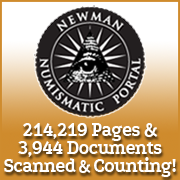
About UsThe Numismatic Bibliomania Society is a non-profit organization devoted to the study and enjoyment of numismatic literature. For more information please see our web site at coinbooks.org SubscriptionsThose wishing to become new E-Sylum subscribers (or wishing to Unsubscribe) can go to the following web page link MembershipThere is a membership application available on the web site Membership Application To join, print the application and return it with your check to the address printed on the application. Membership is only $20 to addresses in the U.S., $25 for First Class mail, and $30 elsewhere. For those without web access, write to: Terry White, Treasurer
AsylumFor Asylum mailing address changes and other membership questions, contact Terry at this email address: terrywhite5475@yahoo.com SubmissionsTo submit items for publication in The E-Sylum, just Reply to this message, or write to the Editor at this address: whomren@gmail.com BUY THE BOOK BEFORE THE COINSale Calendar |
- WAYNE'S WORDS: THE E-SYLUM APRIL 24, 2016
- A VISIT TO KOLBE & FANNING HEADQUARTERS
- GOBRECHT JOURNAL COLLECTIVE VOLUMES AVAILABLE
- ANS BOOK SALE OFFERS CLEARANCE PRICES
- NEW BOOK: ENCYCLOPEDIA OF COIN AND MEDAL TECHNOLOGY
- THE BIBLIOTECA NUMISMATICA BLOG
- MCDOWELL APPOINTED COLONIAL NEWSLETTER EDITOR
- NEWMAN PORTAL SCANS EDWARD COGAN CATALOG SET
- THE MAJOR ERAS OF NUMISMATIC RESEARCH
- GERALD TEBBEN CONTINUES LOOK AT THE RED BOOK
- DO REPRINTS OF ZERBE’S LESHER ARTICLE SURVIVE?
- MORE ON NUMISMATIC BOOK DUST JACKETS
- NOTES FROM E-SYLUM READERS: APRIL 24, 2016
- THE EVERMAN COUNTERSTAMP – A NEW FIND
- FACES OF COUNTERFEITERS PAST
- C. W. FRANKLIN
- ALEXANDER INTERVIEWS ROYAL MINT'S ANNE JESSOPP
- CHANGES TO U.S. PAPER MONEY PORTRAITURE
- THE 11-YEAR-OLD GIRL WHO WROTE TO THE PRESIDENT
- BURNS NUMISMATIC LIBRARY DONATIONS SOUGHT
- PAN AUCTION CLOSES MAY 6, 2016
- SELECTIONS FROM HERITAGE NEWMAN INTERNET PART 1 SALE
- QUERY: FAZL-TARIN COLUMBIAN EXPO MEDAL INFO SOUGHT
- THE GEORGE W. LA BORDE COLLECTION OF ROMAN AUREI
- A PORTRAIT OF ANTINOUS, IN TWO PARTS
- WOMEN ON BYZANTINE GOLD COINS
- THE CASE OF THE LION COUNTERMARK
- THE 1902 TIENTSIN PROVISIONAL GOVERNMENT MEDAL
- A HISTORY OF MONEY IN FIVE OBJECTS
- VIEWING COINS ONLINE IN THREE DIMENSIONS
- MONEY OF THE FUTURE: QUANTUM BANKNOTE PROTOTYPE
- CURATING THE DIGITAL AGE
- DO YOU SUFFER FROM LIBRARY ANXIETY?
- THE LIBRARIAN BY GUISEPPE ARCIMBOLDO
- FEATURED WEB SITE: MINTAGE WORLD
Click here to access the complete archive
To comment or submit articles, reply to whomren@gmail.com
WAYNE'S WORDS: THE E-SYLUM APRIL 24, 2016
New subscribers this week include: Ben Hellings. Welcome aboard! We now have 1,965 subscribers.
This week we open with a visit to the Kolbe & Fanning headquarters, several numismatic book offerings, and several new books not previously discussed.
Other topics this week include numismatic book dust jackets, counterfeiters, Anne Jessopp of the Royal Mint, Pittsburgh dealer C. W. Franklin, the coming changes to U.S. currency, women on Byzantine gold coins, Roman Aurei, and the Quantum banknote.
To learn more about the Encyclopedia of Coin and Medal Technology, the Biblioteca Numismatica blog, the major eras of numismatic research, Zerbe’s article on Lesher Referendum Dollars, William F. Fratcher's printing press, the Numismatic Blue Book, the Tientsin Provisional Government Medal and the best birthday present ever, read on. Have a great week, everyone!
Wayne Homren
Editor, The E-Sylum
A VISIT TO KOLBE & FANNING HEADQUARTERS
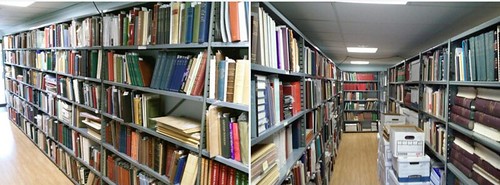
This Thursday I was a guest at the worldwide headquarters of Kolbe & Fanning in Gahanna, OH. Their recently expanded office space is a numismatist’s dream, with dedicated space for photography, shipping, research offices for both David and Maria Fanning, and copious amounts of shelving for stock and consignments.
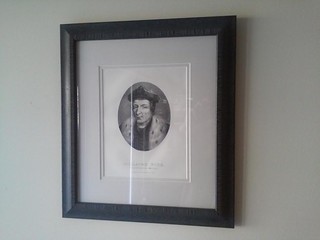 The lobby is graced by an engraving of Guillaume Budé (1467-1540), French scholar and author of the first numismatic book,
De Asse et Partibus Eius (1514). The walls are well adorned throughout with similar numismatic varia, ranging from an award plaque from
the NBS to John Ford, to color plates of a Saint-Gaudens piece from the Eliasberg collection. A print of a “potty dollar” is appropriately
hung upon the door of the restroom.
The lobby is graced by an engraving of Guillaume Budé (1467-1540), French scholar and author of the first numismatic book,
De Asse et Partibus Eius (1514). The walls are well adorned throughout with similar numismatic varia, ranging from an award plaque from
the NBS to John Ford, to color plates of a Saint-Gaudens piece from the Eliasberg collection. A print of a “potty dollar” is appropriately
hung upon the door of the restroom.
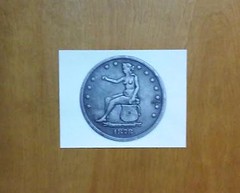 Boxes and boxes come in and go out, and these are located about the different rooms in various stages of processing. Of course I could not
go home empty-handed, and the sale of one item was completed. I also showed David a copy of the book A Superpower is Born: The Rise of the
Dollar, which I had just received from the American Numismatic Society. The opportunity to see so much literature in one place is unusual and I
recommend a tour for anyone passing through the area.
Boxes and boxes come in and go out, and these are located about the different rooms in various stages of processing. Of course I could not
go home empty-handed, and the sale of one item was completed. I also showed David a copy of the book A Superpower is Born: The Rise of the
Dollar, which I had just received from the American Numismatic Society. The opportunity to see so much literature in one place is unusual and I
recommend a tour for anyone passing through the area.
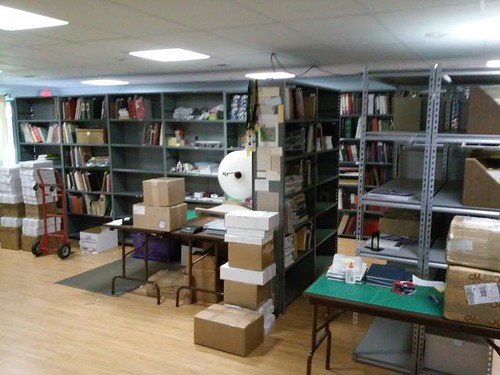
To visit the Kolbe & Fanning web site, see:
http://www.numislit.com/
GOBRECHT JOURNAL COLLECTIVE VOLUMES AVAILABLE
Collective volumes of The Gobrecht Journal published by the Liberty Seated Collectors Club were found and are now available in limited quantities.
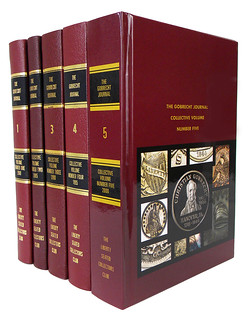 Volume 1 - $20.00
Volume 1 - $20.00
Volume 2 - $20.00
Volume 3 - $20.00
Volume 4 - $20.00
Volume 5 - $50.00
Water Damaged Copies:
(warped pages, no mold or mildew)
Volume 1 - $10
Volume 2 - $10
For more information, or to order, see:
www.numislit.com/searchResults.php?category_id=252&action=browse&orderBy=relevance

ANS BOOK SALE OFFERS CLEARANCE PRICES
The ANS will be selling select books published after 2000 at a deep discount (up to 80% off retail) from April 25–May 8. Titles in the sale are:
- Cultural Change: Jewish, Christian, and Islamic Coins of the Holy Land (by David Hendin, reg. $40/sale $10);
- From Crime to Punishment: Counterfeit and Debased Currencies in Colonial and Pre-Federal America (by Philip L. Mossman, reg. $145/sale $45);
- The Island Standard: The Classical, Hellenistic, and Roman Coinages of Paros (by John A.N.Z. Tully, reg. $120/sale $40);
- The Silver Coins of Massachusetts (by Christopher J. Salmon, reg. $95/sale $45);
- Diva Faustina: Coinage and Cult in Rome and the Provinces (by Martin Beckman, reg. $95/sale $45);
- New Jersey State Coppers (by Roger S. Siboni, John L. Howes, and A. Buell Ish, reg. $235/sale $100);
- Numismatic Finds of the Americas, An Inventory of American Coin Hoards (Treasure Trove), Shipwrecks, Single Finds, and Finds in Excavations (by John M. Kleeberg, reg. $125/sale $40);
- American Journal of Numismatics Vol. 24 (reg. $75/sale $15).
Download an order form for your purchase(s):
http://numismatics.org/wikiuploads/Store/ANSSaleOrderForm.pdf
NEW BOOK: ENCYCLOPEDIA OF COIN AND MEDAL TECHNOLOGY
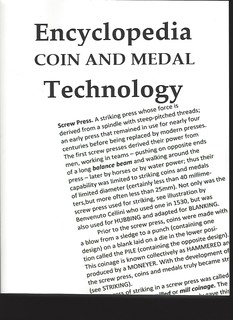 NEW BOOK REVEALS BASIC DATA IN NUMISMATICS – TERMS & TECHNOLOGY
NEW BOOK REVEALS BASIC DATA IN NUMISMATICS – TERMS & TECHNOLOGY
The language and tasks of numismatics –its terms and techniques – are brought into sharp focus in a new publication, An Encyclopedia of Coin and Medal Technology. While not in book form yet, the manuscript has been printed in a preprint, manuscript draft format, a rare occurrence in the numismatic field.
The double column 678-page preprint appears in text only. Because of the technical nature of the subject a great many illustrations are required. When published the work is planned to have 935 photographs, 772 drawings and additional illustrations created by a new computer generated process.
It will appear in two volumes, published as a two-volume set, with a third volume planed for optional purchase to include a Study Guide, numerous appendices and an extensive index.
Preparation of the content has required a 20-year effort by a seasoned numismatist, who has served in six areas in the field gathering knowledge and insight in each endeavor.
The author is D. Wayne Johnson, who E-Sylum readers will recognize by his informal “Dick Johnson” author name. He has been a collector (since 1939), a writer (many articles, two previous books), an editor (Coin World’s first), a medal manufacturer (hands-on experience at Medallic Art Company for a decade), owner of a auction firm (Johnson & Jensen), and curator (Belskie Museum of Art and Science).
His current position is Corporate Historian at Medallic Art Company where he was formerly Director of Research.
It was at Medallic Art when he was being trained in the medallic field that, despite 20 years previous as a collector, he was introduced to a new world of language and technology. He recorded the first two new terms in 1966, “cartouche” and “cliché.” The two terms led to hundreds more, each entered in a notebook, destined to contain definitions, explanations, techniques and references.
After retiring from the auction business he had the time to work on this project. The handful of terms grew to 1,854 which covers how coins and medals are designed and made, the tasks and techniques n every step of the process, revealing the tools and equipment plus how they are used. Added to this are the types of numismatic objects, terms associated with collecting, cataloging and curating.
The technology covers all areas of die-struck items (and cast medals) from ancient times to the present. From hand-cut dies to computer generated models and high speed coining. It covers all areas of coins, medals and tokens, all areas of numismatics except paper money.
The high cost of gathering the great many illustrations for the book has led the author to establish a fund for this purpose. He is offering the preprint manuscript – destined to be considered a rare book –free to anyone who donates $100 or more to the illustration fund.
While the content of the preprint book should appeal to all segments of the numismatic field, its reference value should be considered extensive and universal even in its present format. It can well serve its purpose until the two-volume is published.
The author has underwritten the cost of printing, and will pay for the postage in mailing. Every cent received will be earmarked for gathering the illustrations. Since the fees for PayPal and credit cards would pay for another photo, the author is asking for checks only.
To receive the preprint manuscript send your check of $100 or more and your mailing address to Dick Johnson, 139 Thompson Drive, Torrington, CT 06790-6646.
The $100 price for early access to the manuscript seems cheap for a work of such importance and utility. I hope many E-Sylum readers take him up on this offer. This is valuable information for numismatic authors, researchers and collectors alike, not available in one place anywhere else. -Editor
THE BOOK BAZARRE
THE BIBLIOTECA NUMISMATICA BLOG

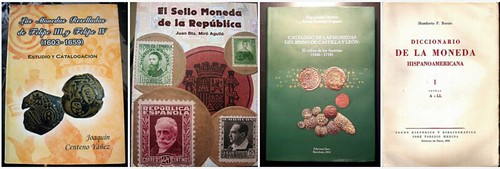
- LAS MONEDAS RESELLADAS DE FELIPE III Y FELIPE IV (1603-1659)
- El Sello Moneda de la República, Monografía del sello de la moneda durante la guerra civil
- EL Vellón de los Austrias (1566-1718), Iñigo Jarabo y Xavier Sanahuja
- Diccionario de la Moneda Hispano-Americana, Humberto Francisco Burzio
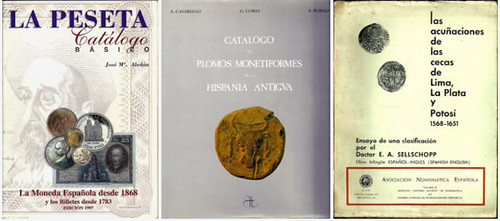
- La Peseta catálogo básico
- Catálogo de Plomos Monetiformes de la Hispania Antigua
- Las Acuñaciones de las Cecas de Lima, La Plata y Potosí 1568-1651
To read the complete blog, see:
http://biblionumismatica.blogspot.com/
MCDOWELL APPOINTED COLONIAL NEWSLETTER EDITOR
 The American Numismatic Society has appointed Christopher R. McDowell as the new editor of the Colonial Newsletter. He and current
editor Oliver Hoover will work together on the third issue for 2016, and he will manage CNL beginning with 2017’s first issue.
The American Numismatic Society has appointed Christopher R. McDowell as the new editor of the Colonial Newsletter. He and current
editor Oliver Hoover will work together on the third issue for 2016, and he will manage CNL beginning with 2017’s first issue.
McDowell was born in Huntington, West Virginia, and as a boy he collected Lincoln cents with his father. His first colonial coin was a 1785 Miller 4.1-F.4, Connecticut. McDowell now has close to 300 different Connecticut copper varieties. He has written many numismatic articles and is the 2009 recipient of the Gloria Peters Literary Award from Women in Numismatics. In 2015 he authored his first book, Abel Buell and the History of the Connecticut and Fugio Coinages.
A student of history and political science at Marshall University, he earned his law degree at West Virginia University where he was the senior editor of the National Coal Issue, West Virginia Law Review. After law school, he entered active duty as an Army Officer and was stationed in Korea, Germany, and Kansas with deployments to Bosnia. In 2000, he left active military service and began practicing law in Cincinnati, Ohio. Additional details about the new direction of CNL will appear in the newsletter and in ANS Magazine.
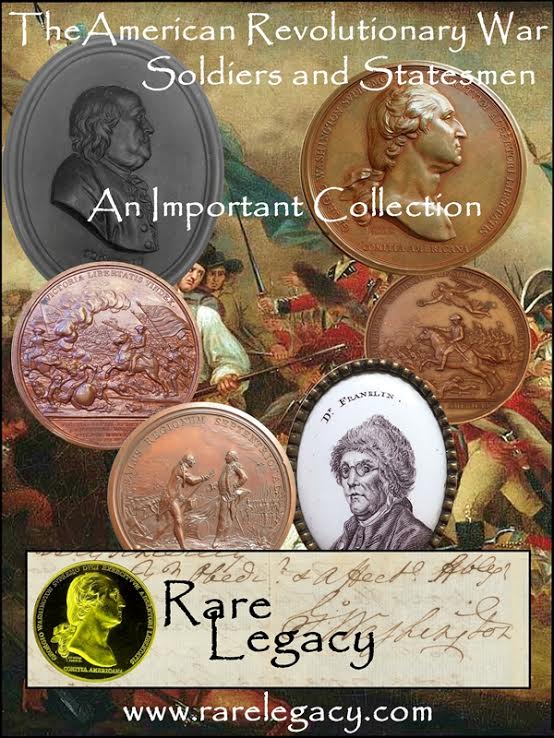
NEWMAN PORTAL SCANS EDWARD COGAN CATALOG SET
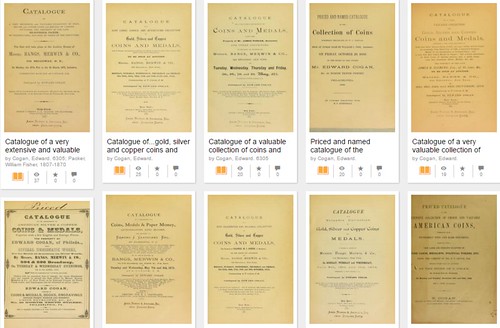
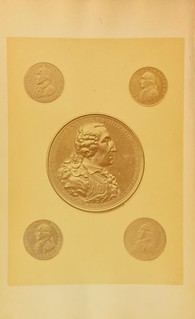 Following up on John Lupia’s biography of Edward Cogan, presented in last week’s E-Sylum, the Newman Portal has completed scanning
of the Edward Cogan auction catalogs. Both Adams (United States Numismatic Literature, Volume One) and Gengerke (American Numismatic
Auctions) count 70 Cogan sales, from 1858 to 1879, and these are all now available on the Newman Portal. This set was primarily scanned at the
American Numismatic Society library, with Dan Hamelberg filling in key items at the end, notably a manuscript copy of the Foote sale (3/7/1859), and
the DeHaven collection catalog (1861, sold en bloc to Lilliendahl).
Following up on John Lupia’s biography of Edward Cogan, presented in last week’s E-Sylum, the Newman Portal has completed scanning
of the Edward Cogan auction catalogs. Both Adams (United States Numismatic Literature, Volume One) and Gengerke (American Numismatic
Auctions) count 70 Cogan sales, from 1858 to 1879, and these are all now available on the Newman Portal. This set was primarily scanned at the
American Numismatic Society library, with Dan Hamelberg filling in key items at the end, notably a manuscript copy of the Foote sale (3/7/1859), and
the DeHaven collection catalog (1861, sold en bloc to Lilliendahl).
The DeHaven catalog was little known to us – we used the Newman Portal itself to search on “DeHaven” and located information from John Adams on this rare Cogan emission. The Cogan series further features the first plated catalog in American numismatics, namely the MacKenzie collection (1869), and the ANS copy presented here is a triple play – plated, priced, and named.
Edward Cogan catalogs on the Newman Portal:
https://nnp.wustl.edu/library/auctioncompanydetail/19
John Lupia’s article on Edward Cogan:
http://www.coinbooks.org/club_nbs_esylum_v19n16.html#article10
John Adams’ note on the DeHaven catalog, from The Asylum:
https://www.archive.org/stream/asylumquarterlyj15n2numi
%23page/16/mode/2up/search/dehaven
MacKenzie catalog on the Newman Portal:
https://nnp.wustl.edu/library/auctionlots?AucCoId=19&AuctionId=510478
THE MAJOR ERAS OF NUMISMATIC RESEARCH
John Kraljevich's observation that the first three Pogue catalogs would each have been a pound heavier if the riches revealed by the Newman Numismatic Portal had been available when they were being researched and written sparked an insight: Like Gaul, the history of numismatic research is divided into three parts.
The Pre-Internet Era
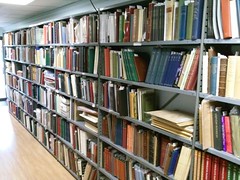 Starting from 1514, when Guillaume Bude wrote De Asse et Partibus Eius, numismatic researchers had to do it the hard way, casting
their nets far and wide for sources, trekking from libraries, to private holdings, to archival repositories, and back to all again, searching for
sources, sifting through possibilities,sorting the relevant from the irrelevant, sending letters hither and yon, and finally writing it all out in
longhand. The achievements of men like Sylvester Sage Crosby, C. Wyllys Betts, and William S. Baker while toiling under these disadvantages is a
matter for wonderment.
Starting from 1514, when Guillaume Bude wrote De Asse et Partibus Eius, numismatic researchers had to do it the hard way, casting
their nets far and wide for sources, trekking from libraries, to private holdings, to archival repositories, and back to all again, searching for
sources, sifting through possibilities,sorting the relevant from the irrelevant, sending letters hither and yon, and finally writing it all out in
longhand. The achievements of men like Sylvester Sage Crosby, C. Wyllys Betts, and William S. Baker while toiling under these disadvantages is a
matter for wonderment.
The Internet Era
 Starting in 1990 (for computer geeks only), or 1994 (with Yahoo! and Lycos), and September 4, 1998 (with Google), things got dramatically
better for the numismatic researcher, for search engines made it possible to reach previously-unimaginable sources of information, all without having
to travel or to subsidize the postal service.
Starting in 1990 (for computer geeks only), or 1994 (with Yahoo! and Lycos), and September 4, 1998 (with Google), things got dramatically
better for the numismatic researcher, for search engines made it possible to reach previously-unimaginable sources of information, all without having
to travel or to subsidize the postal service.
Search engines were the great equalizer, making any of us feel like S.S. Crosby for a day when we found some important, but heretofore obscure fact in Mr. Google's haystack. That was the problem, though--it was a haystack, with millions of stalks returned to you for every search. There were needles of information hidden within, but who had the time (or fanaticism) to search through tens of thousands, much less millions, of completely pointless links? Nor was it possible that even Google had the algorithms necessary to find every pertinent numismatic fact.
The Newman Numismatic Portal Era
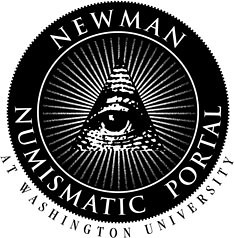 Starting March 10, 2016, another epoch opened in numismatic research. The Newman Numismatic Portal began providing content that had been
chosen, scanned, and aggregated to be relevant to specific numismatic searches. When fully built out, the NNP will offer Google's encyclopedic
reach without Google's millions of irrelevant results. NNP will be what the numismatic researcher has always wanted, but never before had: an
accurate index to every numismatic publication, a reliable guide to all things on topic.
Starting March 10, 2016, another epoch opened in numismatic research. The Newman Numismatic Portal began providing content that had been
chosen, scanned, and aggregated to be relevant to specific numismatic searches. When fully built out, the NNP will offer Google's encyclopedic
reach without Google's millions of irrelevant results. NNP will be what the numismatic researcher has always wanted, but never before had: an
accurate index to every numismatic publication, a reliable guide to all things on topic.
The NNP will reveal those facts of consequence and those seemingly of little moment, but, crucially, everything, every relevant thing, listed there for the researcher to ponder, decide, and to use. There will be more Crosbys and Bakers among us, because our tools have become infinitely better. A golden age of numismatic research and writing has begun, and we will date it to March 10, 2016 when the Portal first opened for us.
Future Eras
 It's a great time to be a numismatist. Use of the Newman Numismatic Portal should by now be mandatory for anyone beginning research on
American numismatics. But as valuable as it is, NNP will only continue to get better over time, not only as new content is added, but as new features
appear and evolve.
It's a great time to be a numismatist. Use of the Newman Numismatic Portal should by now be mandatory for anyone beginning research on
American numismatics. But as valuable as it is, NNP will only continue to get better over time, not only as new content is added, but as new features
appear and evolve.
Science fiction author William Gibson once said, "The future is already here — it's just not very evenly distributed." So we don't have to wait for some new space-age technologies to be invented - they're already here. Technologists in government and industry are already making use of tools and techniques that could one day speed numismatic research by yet another order of magnitude - things such as image recognition, feature extraction,and machine-learning based classification systems.
With continued support and development, important new features could one day come to NNP and many of your favorite numismatic web sites. What would your ideal "EASY BUTTON" look like? What would it do for you? -Editor
To visit the Newman Numismatic Portal, see:
http://www.newmanportal.org
To read the earlier E-Sylum article, see:
BUILDING THE D. BRENT POGUE COLLECTION
(www.coinbooks.org/esylum_v19n16a05.html)
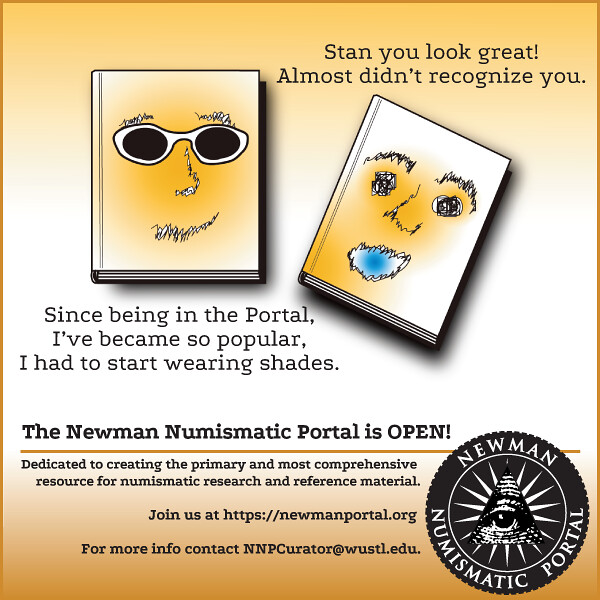
GERALD TEBBEN CONTINUES LOOK AT THE RED BOOK
The Good Samaritan Shilling
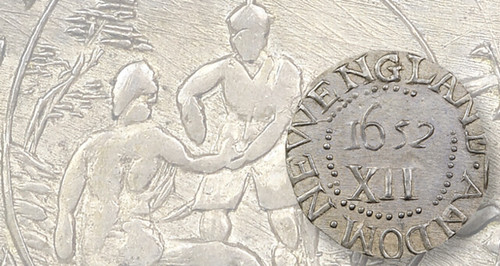
The Good Samaritan shilling, a famous 19th century fraud, might be the only coin to be delisted from the R.S. Yeoman's A Guide Book of United States Coins, the Red Book.
The “coin” was considered a great rarity in the 1940s and ‘50s. For the first dozen or so editions, the Red Book write-up described the piece:
“The Good Samaritan Shilling, supposed to be a pattern piece, was struck at a Boston mint and is extremely rare. This piece is of the same general type as the Pine Tree Shilling, but has a device illustrating the parable of the Good Samaritan on the obverse. It is in silver and dated 1652 on the reverse.”
Sylvester S. Crosby, in his groundbreaking 1876 work The Early Coins of America, acknowledged that some doubt the genuineness of the piece, but he was convinced it was a Massachusetts silver pattern. “I am to a considerable extent justified in regarding it as genuine, in the absence of anything like proof to the contrary,” he wrote.
In 1959, numismatic researcher Eric P. Newman blew that argument apart, exposing the piece as a fraud. In The Secret of the Good Samaritan Shilling Newman said the Good Samaritan Shilling “was the ‘fakest’ coin in history!”
In 1848 the British Museum purchased a Good Samaritan Shilling that was known to exist as early as 1730. The coin, Newman determined, was a Pine Tree Shilling on which the obverse had been ground off and replaced with the seal of the British Commission of Sick and Wounded, a 17th century precursor of the Red Cross. English coin dealer Thomas Snelling and American dealer Thomas Wyatt separately faked their own versions of the supposedly genuine coin and palmed them off on unsuspecting collectors.
The Red Book continued to list the piece for a few years after Newman exposed the fraud, but changed the text. “Although this piece was formerly thought to be a pattern for the 1652 shillings, recent findings show that the known specimens are all fabrications.”
The King of Coins - the 1804 Dollar
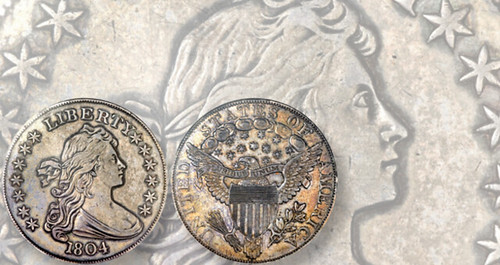
The 1804 dollar has always been a coin of mystery and desire. Was it struck in 1804 or decades later? In 1946, when the first Red Book was printed, both sides had their adherents. The Red Book told the story down the middle, giving both sides of the argument, but offering no conclusion.
For the first 15 editions, the Red Book reported, “Those who adhere to the belief that these coins were struck in 1804 point to such evidence as the letter written by Robert Patterson, Director of the Mint, to President Thomas Jefferson. This letter stated that no dollars had been minted ‘during the last two years.’ Inasmuch as the letter was dated April 2, 1807, they infer that dollars were struck during 1804.
“Mint records show that 19,570 silver dollars were coined in 1804 and that these coins were struck after March 28, 1804.”
The 1804 dollar text concluded, “The 1804 dollar has been and probably will continue to be a subject of much discussion. Unless some new evidence is uncovered the mystery of its existence or disappearance will always be a matter of speculation for the numismatic fraternity”
In 1962, Eric P. Newman and Kenneth Bressett, who went on to edit the Red Book, set the record straight with the publication of The Fantastic 1804 Dollar. No 1804-dated dollars were produced before 1834, when the Mint struck display sets of coins for diplomatic missions. Years later, a handful more (Class II) were secretly struck at the Mint for sale to connected collectors.
The 1963-dated 16th edition of the Red Book updated the controversy, saying, “Numismatists now know that the 1804 ‘original’ dollars were struck at the mint between 1836 and 1842.”
In the years since 1963, the Red Book text has been updated to reflect current research. It now reads, “Numismatists have found that the 1804 original dollars were first struck in the 1834 through 1835 period for use in Presentation proof sets.”
To read the complete articles, see:
RED BOOK 70TH ANNIVERSARY: THE KING OF COINS
(www.coinworld.com/voices/gerald-tebben/2016/04/red_book_70th_annive.html)
RED BOOK 70TH ANNIVERSARY: THE GOOD SAMARITAN
SHILLING (www.coinworld.com/voices/gerald-tebben/2016/04/_red_book_70th_anniv.html)
To read the earlier E-Sylum article, see:
GERALD TEBBEN LOOKS AT THE RED BOOK
(www.coinbooks.org/esylum_v19n14a11.html)
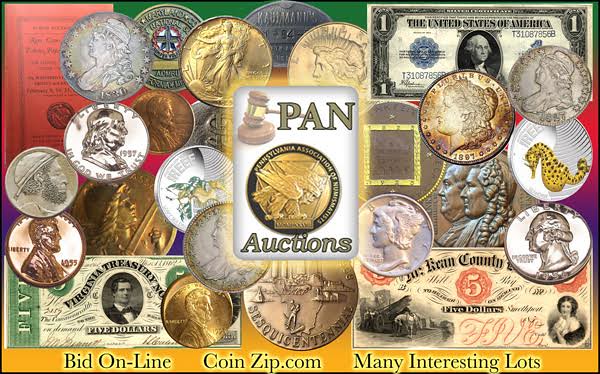
DO REPRINTS OF ZERBE’S LESHER ARTICLE SURVIVE?
George Kolbe of Kolbe & Fanning Numismatic Booksellers had an interesting question regarding my most recent column in ANS Magazine (“Bumps in the Road as ‘Coin Zerbe’ became the Dean of Coin Collectors,” 2016:1).
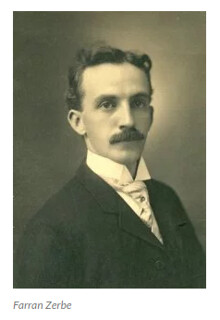 It relates to some correspondence in the ANS Archives documenting a dustup between coin dealer B. Max Mehl and legendary numismatic
evangelist Farran Zerbe. Zerbe had become quite perturbed upon learning that Mehl had, without permission, reproduced Zerbe’s article on Lesher
Referendum Dollars in Mehl’s own Numismatic Monthly.
It relates to some correspondence in the ANS Archives documenting a dustup between coin dealer B. Max Mehl and legendary numismatic
evangelist Farran Zerbe. Zerbe had become quite perturbed upon learning that Mehl had, without permission, reproduced Zerbe’s article on Lesher
Referendum Dollars in Mehl’s own Numismatic Monthly.
The article had first appeared in the 1917 volume of the American Journal of Numismatics. In those days, the ANS routinely supplied its authors with fifty offprints of articles published in the AJN, and Zerbe apparently had big plans for his—namely, selling them. But when the article appeared in Mehl’s publication—“killing whatever market or appreciation there may have been”—his enthusiasm evaporated, and he never bothered obtaining them. Years later, he asked Howland Wood if they were still available.
That is what prompted George to write. “I could not recall ever having seen or handled a copy of the AJN reprint of Zerbe’s Lesher article,” he says. “Were the Zerbe Lesher reprints ever produced and, if so, did Zerbe take possession?”
Good question! And, though it’s not often the case, this is one time when it was pretty easily and conclusively answered with a quick dive back into the correspondence. It turns out the reprints were indeed printed. In fact, Zerbe writes of having received two when the article was published. As for the others? Wood went poking around in the basement of the old building at Audubon Terrace and also wrote to the printer. But no luck. “They must have gotten lost or been destroyed,” he told Zerbe. “Such is the way of things.”
Were Zerbe’s two copies the only ones to survive? And what became of those? I know that George spent some time looking around, consulting his and other sales of the remnants of Zerbe’s library (e.g., Katen’s sale of Chase’s World Money Museum numismatic library in 1986 and 1987) but he found no clues. The ANS Library does not have any of the reprints in its catalog, so there are no “official” copies on our shelves. But I will be keeping an eye out!
Has anyone encountered reprints of Zerbe’s article?
To read the complete article, see:
DID ANY REPRINTS OF ZERBE’S LESHER ARTICLE
SURVIVE? (www.anspocketchange.org/did-any-reprints-of-zerbes-lesher-article-survive/)
MORE ON NUMISMATIC BOOK DUST JACKETS
Your conjecture is manifestly correct of course. There is no way to determine if a book was issued in a dust jacket beyond documenting that such is the case. And there are “wrinkles.”
Originally, a dust wrapper or dust jacket was intended to protect a new book from its adjective until the volume in question was sold. Having served its purpose it was then often discarded. Many earlier dust jackets feature no printing. Among numismatic works fitting that criterion are Horatio Robinson Storer’s 1931 Medicina in Nummis and Richard Bowen’s 1942 Rhode Island Colonial Money and Its Counterfeiting, to name but a few American publications. Even a numismatic bookseller employed the practice, witness the 1984 catalogue of the Lester Merkin library.
Modern dust jackets have little to do with solid particulate matter and everything to do about marketing. Plain dust jackets stifle sales. Imagine a bookstore display of the 1931 and 1942 works [1] mentioned above: an unending blob of brown kraft paper. Blah! Contrast that with an image of Tarzan, vanquishing a lion and saving a beautiful maiden, in full color. I doubt any of those are still lying around, mint in their original pictorial jackets.
In numismatic circles, the presence or absence of a dust jacket generally has but a modest impact on value. The opposite is often true in the general world of books, particularly modern fiction. There, an original dust jacket is typically worth more than the volume it encompasses. Many modern novels feature dust jackets designed by talented and famous artists of the day and their presence and, particularly, their state of preservation, is key. Suffice it to say that not only are coins counterfeited. Replicas of older pictorial dust jackets have become a plague in the book world. Luckily, their detection at present is easier for those with a discerning eye, due to the unavailability of the raw materials involved (paper and ink), combined with the obsolete technologies involved.
[1] Neither were commercially published and their paper covers likely stifled sales; decades after publication your scribe purchased multiple brand new copies of both, with dust jackets intact.
I believe the increasing level of digitization of numismatic literature will greatly increase attention to physical details of the books we collect, from overall condition to the presence of original dust jackets. Over time this could lead to higher prices for the rare surviving intact dust jackets.
For many years I upgraded my books whenever given the opportunity, and I placed Brodart protectors over many of my dust jackets. I have at least a few numismatic dust jackets in near perfect condition. I've always been proud of this minor accomplishment, even though few others cared. Time will tell if the effort was worth it financially, but at least I can feel good about saving a few of them from the landfill. -Editor
To read the complete article, see:
NOTES FROM E-SYLUM READERS: APRIL 17, 2016
(www.coinbooks.org/esylum_v19n16a07.html)
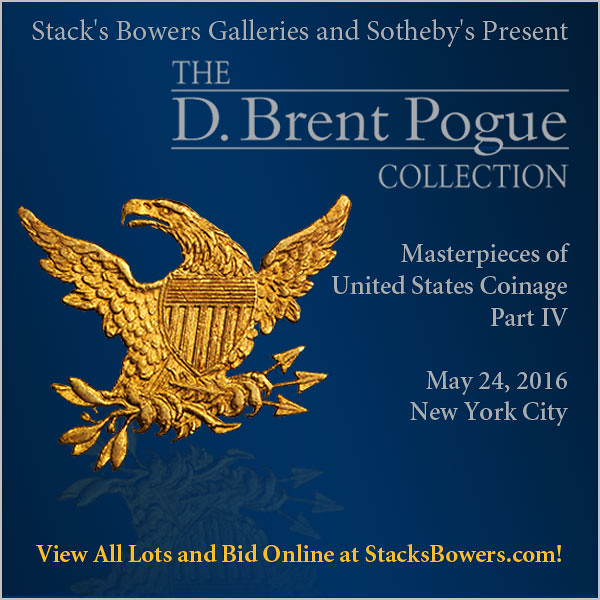
NOTES FROM E-SYLUM READERS: APRIL 24, 2016
Finding Time to Work on The E-Sylum
Mike Sanders writes:
I can't tell you how much I admire your love and dedication to our hobby. The amount of time that you dedicate to The E-Sylum is truly admirable. I don't know how you find the time and patience to do this every week!
Alia's Mission: Saving the Books of Iraq
Susie Nulty writes:
When I read the article on The Bad-Ass Librarians of Timbuktu, it reminded me of the children's book, Alia's Mission: Saving the Books of Iraq by Mark Alan Stamaty, although my favorite children's book of Stamaty's is Who Needs Donuts? which has amazing illustrations and a very sweet story.
To read the earlier E-Sylum article, see:
NEW BOOK: THE BAD-ASS LIBRARIANS OF TIMBUKTU
(www.coinbooks.org/esylum_v19n16a02.html)
More On Equestrian Depictions of QEII on Coinage
Chip Howell writes:
I'm willing to bet you HAVE seen it before, and forgotten--she's been depicted at least TWICE on horseback, on the crown, first in 1953, then in 1977, on her silver jubilee.
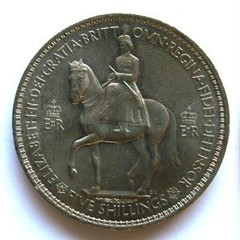
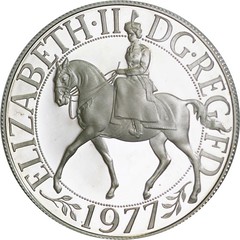
To read the earlier E-Sylum article, see:
AN EQUESTRIAN QUEEN ELIZABETH II ON COIN
(www.coinbooks.org/esylum_v19n16a17.html)
On Nostalgia In U.S. Coin Designs
Responding to the critics mentioned in Lou Golino's piece on coin design in the U.S., an E-Sylum reader writes:
I am very tired of the hyperconservative nostalgia that objects to anything other than a dead president or caucasian female on US coins.
St. Gaudens and Weinman created some lovely coins, but they have been dead for a long time. So also the designers of the Draped Bust, Seated, Barber and all other earlier coinages. Let their work live in the old coins they created. If you want nice, pretty examples of that kind of work and don’t have the budget for a real example, the Gallery Mint pieces are lovely and available at very reasonable cost. I love those pieces, too, but the world moves forward, not backward.
This is the 21st century. Get used to it.
To read the earlier E-Sylum article, see:
GOLINO ON MODERN U.S. COIN DESIGN
(www.coinbooks.org/esylum_v19n16a25.html)
William F. Fratcher's Printing Press
Dave Lange writes:
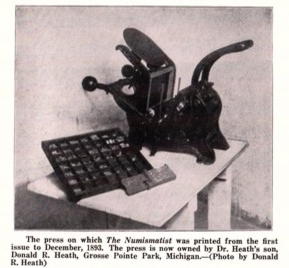 In response to Pete Smith's challenge to identify the role played by W. F. Fratcher in the history of the ANA, I've found a
connection. In 1888 William F. Fratcher of Detroit swapped his small press with Dr. George Heath for $25 cash and a group of stamps. Heath then used
this press to print early issues of The Numismatist.
In response to Pete Smith's challenge to identify the role played by W. F. Fratcher in the history of the ANA, I've found a
connection. In 1888 William F. Fratcher of Detroit swapped his small press with Dr. George Heath for $25 cash and a group of stamps. Heath then used
this press to print early issues of The Numismatist.
W. H. Fratcher was born in New York in 1868 and thus would have been quite a young man when the transaction occurred. The 1930 federal census shows him married and living in Detroit as a proprietor of philatake [sic] supplies. In earlier censuses he is listed in various other fields, such as news vendor or dealer in novelties. I suppose most stamp and coin dealers of that time drifted into it from other careers.
He and wife Luella [spellings vary] had a son, Vernon C. Fratcher, who was born in 1890. Vernon owned a confectionery business at the time of his WWI draft registration and is listed as an attorney in the meat industry in the 1940 federal census, so he obviously didn't follow his father into the hobby business. Dad must have been about 74 when the 1942 photo was taken, assuming that he was still living then. I couldn't find an entry for him in the 1940 federal census.
To read the Numismatist article (ANA Members only), see:
The Numismatist
(www.exacteditions.com/read/thenumismatist/september-1963-44636/5/3?dps=)
To read the earlier E-Sylum articles, see:
MORE ON THE MICHIGAN STAMP AND COIN COMPANY
(www.coinbooks.org/esylum_v19n16a06.html)
THE NUMISMATIST CELEBRATES ITS 125TH ANNIVERSARY
(www.coinbooks.org/esylum_v16n05a13.html)
David Lange Coin Boards Updates
Dave Lange adds:
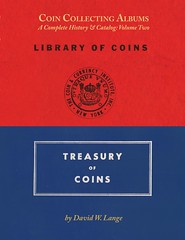 On another topic, I've learned from the printer that my new book will ship to me April 26. I'll be at the Central States show in
Schaumburg that week, so I'm having just a few copies shipped there directly and will have the book for viewing and order taking on Friday and
Saturday. For those who've already ordered, deliveries will begin the following week.
On another topic, I've learned from the printer that my new book will ship to me April 26. I'll be at the Central States show in
Schaumburg that week, so I'm having just a few copies shipped there directly and will have the book for viewing and order taking on Friday and
Saturday. For those who've already ordered, deliveries will begin the following week.
On yet a final topic, I've begun rebuilding my coin board website, though it's still not complete. The design is a bit plain for now, as my focus has been on getting the text and images loaded. I'll dress things up a bit, as time allows. I invite readers to take a look at this work in progress.
For more information on Dave's new book, see:
NEW BOOK: COIN COLLECTING ALBUMS, VOLUME TWO
(www.coinbooks.org/esylum_v19n11a03.html)
To visit David Lange's new website, see:
www.coincollectingboards.com
Mico Kaufman and Bob’s Big Boy
In last week's review of the new biography of sculptor and medallist Mico Kaufman, Dick Johnson notes that "one of his creations
... was Burgerboy, the colorful trademark for the Burger Boy chain of restaurants." Harry Waterson writes:
 The restaurant I believe Dick is referring to is Bob’s Big Boy. Attached is a picture of the Big Boy himself. My recollection is that the
figure was first drawn by a Disney animator on a napkin. I had my first Big Boy at the restaurant in Toluca Lake, CA in 1968.
The restaurant I believe Dick is referring to is Bob’s Big Boy. Attached is a picture of the Big Boy himself. My recollection is that the
figure was first drawn by a Disney animator on a napkin. I had my first Big Boy at the restaurant in Toluca Lake, CA in 1968.
To read the earlier E-Sylum article, see:
BOOK REVIEW: A CHISELER’S TRUE STORY
(www.coinbooks.org/esylum_v19n16a03.html)
More on the Ottoman Coin Embossed Postcard
Nureddin Gurinar writes:
My thanks to David Gladfelter for his contribution. First of all, as I said I saw this card by chance for the first time and found it very peculiar and interesting to me, and just purchased.
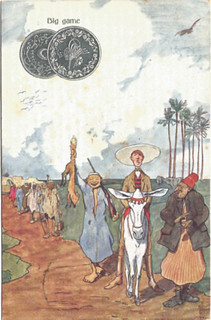 With regard to the coins, I asked a friend of mine who collects Ottoman coins and informed me as follows if I am not wrong:
With regard to the coins, I asked a friend of mine who collects Ottoman coins and informed me as follows if I am not wrong:
a) The full image : Belonging to Sultan Abdulhamid’s era (Abdulhamid II ) ( 1293 - 1327 AH = 1876 - 1909 AD) , 1 kurush, nickel alloy, actual size image on the card and minted at Egypt Mint during his reign.
b) other coin partly under the 1 kurush : Again Abdulhamid II, 5/10 kurush, (“ as cited by the Ottoman coin collectors”), infact it is “half kurush” minted at Egypt Mint, nickel alloy, actual size image on the card.
The first year of Sultan’s reign, 1293, is clearly seen on it. Though clearly minted and easily read by everybody a big “ 5 “ on reverse, but it is NOT 5 silver kurush. Contrary it is the nickel coin of “5/10 kurush”, or in other words “20 paras” , or “half kurush“ as commonly called.
Lastly, again I am looking forward to hear from your estemeed subscribers other varieties of Brüder Kohn, Vienna cards, if any, bearing similar “embossed coin images”.
To read the earlier E-Sylum articles, see:
AN OTTOMAN COIN EMBOSSED POSTCARD (www.coinbooks.org/esylum_v19n14a30.html)
MORE ON THE OTTOMAN COIN EMBOSSED POSTCARD
(www.coinbooks.org/esylum_v19n15a27.html)

THE EVERMAN COUNTERSTAMP – A NEW FIND

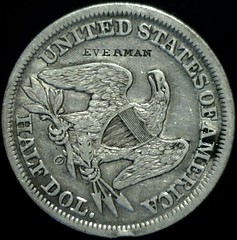
Until last week, the ownership of an EVERMAN counterstamp had long eluded me. I then managed to scoop one up at the Dalton, Georgia show. While this host coin is not a rare one, it is now, to the best of my knowledge, the latest dated one. It is an 1857O half that is strategically stamped in the fields on both sides; this, as are other known specimens.
In a June, 2015 article, Mystery of the Everman Counterstamp, Eric Schena logically ruled out William Everman, a California gold miner, as an issuer of this mark. Eric's research revealed that William succumbed to a hangman's noose in 1853, so it's unlikely that known, later dated coins, struck between 1854-56, were subjected his mark. Eric suggested a far more likely issuer in the person of Lewis Everman who worked as a silversmith in Huntingdon, Tennessee in the 1850's.
Thereafter, in a June, 2015 E-Sylum article, I offered the possibility of another likely issuer by the name of Charles Everman, a jeweler, who appears in Boyd's 185960 Lancaster County, PA directory, compiled in 1858. The tiny letters in the Everman counterstamp are ideally suited to the occupations of jeweler, silversmith and/or watchmaker. As Eric reasonably noted, a piece of flatware might yet be found that bears this mark. Also, a matching mark may exist on a watch or jewelry item, aiding in attribution.
I found an abstract from the West Tennessee Whig, dated January 19, 1854 which noted, “Mr. Lewis B. Everman, Silversmith & Jeweler, has just located in Jackson and opened a shop in the 2 room on Main street East of Patterson's Inn.” Further research reveals that Lieutenant Lewis B. Everman later served with distinction in the Confederate Infantry, Company L of the Sixth Tennessee.
Eric Schena found that Lewis, apparently having survived the Great War, was working as Everman & Spence, jewelers in Jackson, Tennessee in 1866. Did he and his partner then use counterstamps? If so, I have yet to see one.
The whereabouts and circumstances of Charles Everman, Philadelphia jeweler, beyond the year 1858 presently remains as much of a mystery as the Everman counterstamp, itself. Then, along comes this Everman counterstamp, dated 1857. If Lewis B. Everman produced this counterstamp, may we yet see a host coin beyond 1858? If not, it's my guess that the more mysterious Charles is our man, as this 1857 half dollar so closely coincides with his last known presence. If so, IMHO, it remains a coin toss as to whom issued this counterstamp.
Meanwhile, Eric Schena and I share the enjoyment of a good mystery and a good counterstamp.
Eric Schena adds:
I am hoping that as additional contemporary accounts are digitized that perhaps someday we can definitively pin this issuer down. Until then, I will keep enjoying the chase.
To read the earlier E-Sylum articles, see:
NEW RESEARCH ON THE EVERMAN COUNTERSTAMP
(www.coinbooks.org/esylum_v18n23a16.html)
MORE RESEARCH ON THE EVERMAN COUNTERSTAMP
(www.coinbooks.org/esylum_v18n24a15.html)
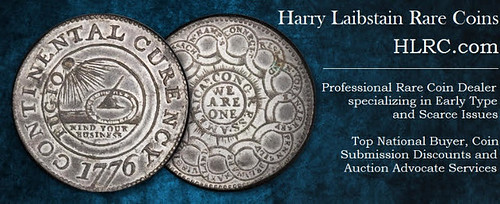
FACES OF COUNTERFEITERS PAST
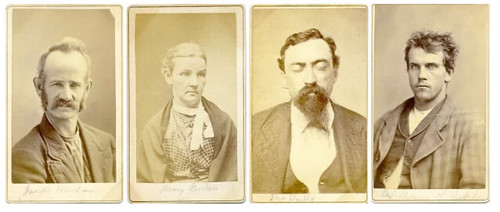
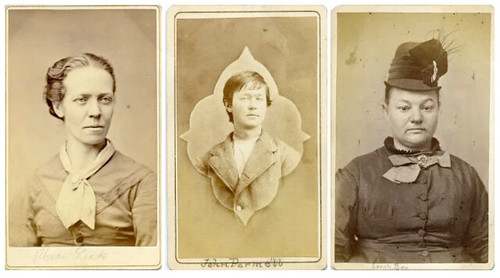
Last year marked the sesquicentennial of the establishment of the United States Secret Service, the federal law enforcement agency assigned to protect the nation’s highest elected leaders and investigate and prevent counterfeiting activities. However, when the agency was formed on July 5, 1865, their mission was not twofold but rather concerned with combating the illegal production, or counterfeiting, of money in the post-Civil War years. It wasn’t until after the assassination of President William McKinley in 1901, that the Secret Service began their protection duties.
By the end of the Civil War, between one-third and one-half of all the currency in circulation was counterfeit. Prior to a national currency, the ability of state banks to print their own currency led to a myriad of banknotes with various designs in circulation. By 1867, Congress had expanded the agency’s investigative duties to include any acts of fraud against the federal government.
As individuals were arrested for counterfeiting and other fraudulent activities, their photographs were taken and placed into albums where they served as a visual record of criminals for the Secret Service. Copies of the mugshots were sent to Secret Service headquarters in Washington, DC and then distributed to district offices across the country, including Cleveland, OH; Philadelphia, PA; and Pittsburgh, PA. The reverse side of the photographs provide varying levels of information about those arrested – from vital statistics, peculiar characteristics, and arrest information to simply the offender’s name.
In describing the offenders, the Chief of the Division (from 1888-1890), John S. Bell, urged agents to “take personal pride in carrying out the most minute details…” An example of this detail is observed in the description of George W. Shamen, “small creases on both cheeks; slow swinging walk; very quiet in his manner.” Also worth noting is the legitimate occupation of those arrested; a number of individuals held jobs as artists and printers which, without a doubt, assisted in the manufacturing of counterfeit notes and coins.
To read the complete article, see:
Faces of Counterfeiters Past: Mugshots from the United States Secret Service Collections
(https://unwritten-record.blogs.archives.gov/2016/03/29/faces-of-counterfeiters-past-mugshots-from-the-united-states-secret-service-collections/)

C. W. FRANKLIN
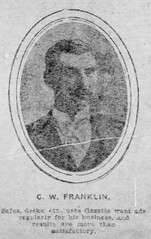 Who in the world is C. W. Franklin? He is an aloof and evasive figure in American numismatic history though he was a successful coin dealer
for about seven years and published several numismatic publications.
Who in the world is C. W. Franklin? He is an aloof and evasive figure in American numismatic history though he was a successful coin dealer
for about seven years and published several numismatic publications.
Though we know sufficiently about his numismatic dealings we know virtually nothing about him as a person. Was he born in Pittsburgh? Was he married? Did he have children? Where did he go to school? Carefully studying his penmanship and spelling skills in the Chapman Brothers correspondence it is obvious he did not attend college and therefore used the title Doctor rather loosely.
These and many other personal questions remain unanswered about his private life and background. Curiously he frequently went about with the title Doctor C. W. Franklin, yet no record of his college studies has yet been discovered. After reading his postal cards sent to the Chapman Brothers it is clear he had very little schooling and was an unlettered man. We know nothing of his personality and character which very well may have amply compensated him for his lack of eloquence and refinement. We can only assume he was a cheerful man of good character which is reflected somewhat in two feature articles about him and coins published later on.
His enthusiasm and passion for coins is very evident in his advertisements and letters as well as in his 1907 book that seems to have become completely forgotten and lost to posterity save the one extant copy in the Lupia Numismatic Library. It is an important work in the history of auction sales since it opens the door shedding light on the market from 1905 to 1906. A book of such importance was not well received since few copies were ever purchased. He wound up offering them at discount prices and kept slashing the price from one dollar to twenty-five cents probably selling few or none. One copy was given to the Carnegie Institute as a gift by him about 1907 or thereabouts, and another to the editor of The Numismatist who ran a notice in the July issue 1907.
Franklin is an interesting personality judging from his myriad of newspaper advertisements and numerous correspondence with the Chapman Brothers. He sold coins, paper money, rare gold, stamps, curiosities, Indian relics, cash registers, and fire and burglar proof safes. On one occasion he even sold a meat market and on another he sold billiard equipment.
[W]e find him corresponding with the Chapman Brothers purchasing numismatic items in the Fall of 1904.
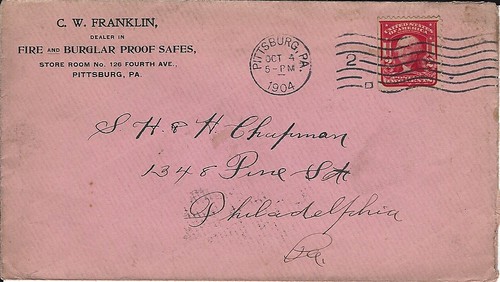
The coins purchased from the Chapman Brothers were not his exclusive stock as a dealer. He ran ads selling Gold Quarters and Half Dollars in the same advertisements selling his burglar proof safes.
 Fig. 7. C. W. Franklin advertisement with his new address at 126 Fourth Street, Pittsburgh, Pennsylvania. His new store becomes combined
business with selling discounted and used safes and cash registers together with old coins. Here we see his ad selling gold quarters and half dollars
twice their face value. Pittsburgh Weekly Gazette, Friday, October 21, 1904, page 11.
Fig. 7. C. W. Franklin advertisement with his new address at 126 Fourth Street, Pittsburgh, Pennsylvania. His new store becomes combined
business with selling discounted and used safes and cash registers together with old coins. Here we see his ad selling gold quarters and half dollars
twice their face value. Pittsburgh Weekly Gazette, Friday, October 21, 1904, page 11.
 Fig. 8. C. W. Franklin advertisement claiming "The largest collection of old coins ever shown in the city of Pittsburgh, both European
and American" Apparently a rival or at least a reasonably fair competitor to Thomas Lindsay Elder in the day at Pittsburgh before Elder moved to
New York City in May 1904. Lachesis throws her mysterious dice leaving us in our day wondering "Who in the world is C.W. Franklin?"
Pittsburgh Press, Wednesday, October 26, 1904, page 15.
Fig. 8. C. W. Franklin advertisement claiming "The largest collection of old coins ever shown in the city of Pittsburgh, both European
and American" Apparently a rival or at least a reasonably fair competitor to Thomas Lindsay Elder in the day at Pittsburgh before Elder moved to
New York City in May 1904. Lachesis throws her mysterious dice leaving us in our day wondering "Who in the world is C.W. Franklin?"
Pittsburgh Press, Wednesday, October 26, 1904, page 15.
 Fig. 9. The above advertisement was a frequently published one offering 25 foreign coins each from a different country together with an old
Roman coin, all for the price of one dollar. Pittsburgh Press, Friday, November 25, 1904, page 22.
Fig. 9. The above advertisement was a frequently published one offering 25 foreign coins each from a different country together with an old
Roman coin, all for the price of one dollar. Pittsburgh Press, Friday, November 25, 1904, page 22.
On January 6, 1907 he was the subject of a feature story, "Rare And Valuable Coins Have Been Collected in Pittsburgh," Pittsburgh Daily Post, Sunday, January 6, 1907, page 29. Apparently he caused quite a stir in Pittsburgh stimulating the imaginations of the public and creating a want for the coin market. He was certainly the starlight of the Pittsburgh coin industry in the first decade of the twentieth century.
On March 10, 1907 another feature story written by Mrs. A. B. Sperry, "Some of the World's Oldest Coins Owned by Pittsburgh Collectors," Pittsburgh Daily Post, Sunday, March 10, 1907, page 42.
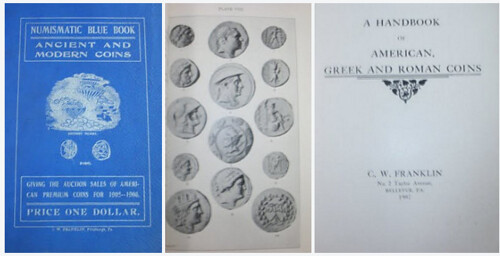
Figs. 33, 34 & 35. C. W. Franklin, Numismatic Bluebook; Ancient and Modern Coins; Giving the Auction Sales of American Premium Coins for 1905-1906. A Handbook of American, Greek and Roman Coins. (Bellevue : C. W. Franklin, 1907). Courtesy Lupia Numismatic Library. It is rather unfortunate that he authored numismatic works neither listed in Clain-Stefanelli, Remy Bourne, nor in Davis, apparently having become completely lost to posterity.
The mysterious Doctor C. W. Franklin seems to have styled himself after Ben Franklin who also was called Doctor Franklin. He certainly created a breeze in the Pittsburgh coin world but seems to have been a dud in the mainstream of coin collectors and dealers never having been a member of any numismatic association unless this author's weary eyes missed that entry. Reading through his numerous advertisements which only a few have been published here one learns he dealt with a wide variety of gold coins and other rarities.
To read the complete article, see:
FRANKLIN, C. W.
(https://sites.google.com/a/numismaticmall.com/www/numismaticmall-com/franklin-c-w?pli=1)
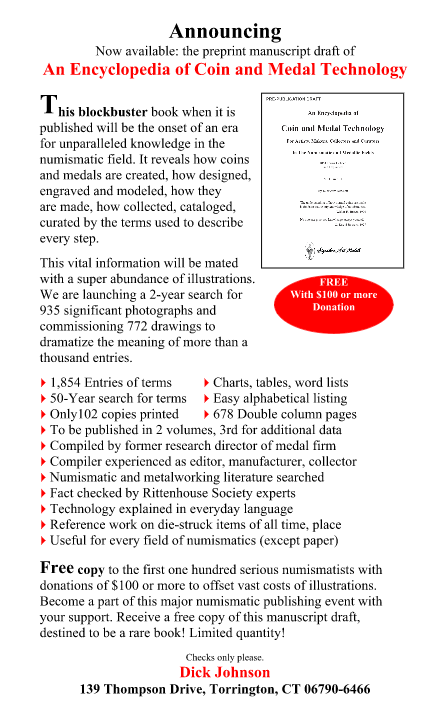
ALEXANDER INTERVIEWS ROYAL MINT'S ANNE JESSOPP
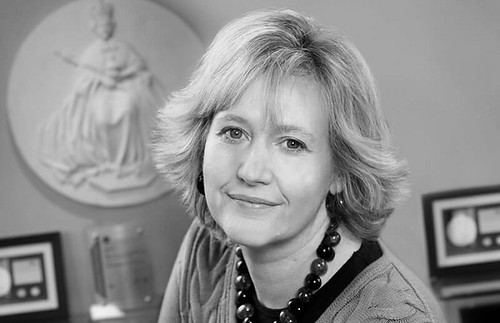
MA: Your new job as Director of Commemorative Coin essentially means that your department is responsible for the themes and marketing of coins issued for national anniversaries and events. Is there a part of your position that might surprise someone reading this interview, perhaps including me?
AJ: My role is not only the sales and marketing of commemorative coin, but also the whole value stream. So, the team won’t just hear me talking about marketing commemorative coins – I am equally likely to be heard asking if we are dispatching in the right way, and whether we are manufacturing on time. What is the quality like? Are we delivering coins that are worthy of the world’s best mint? It’s about continuous improvement across the whole of the Royal Mint, and how the actions of all departments fit together to make an impact on our customers in the best possible way.
MA: Under your predecessor, the department you now head met with a lot of advantageous and significant occasions, such as the Olympics and the Diamond jubilee, which introduced a variety of products to the collector. Some were more successful and popular than others; was there anything to be learned by the products that didn’t perform as well? If so, what can collectors expect to see regarding changes in upcoming or future products?
AJ: The Royal Mint has had the responsibility of marking occasions of state and significant events on Britain’s coinage for over 1,000 years; it’s to be expected that some will resonate more with the public than others. It’s quite a challenge, as there are always so many deserving events and people to choose from. The rigorous selection process (the Royal Mint Advisory Committee, final approval from The Queen) gives us the confidence to know that themes that finally make it through are without a doubt the ones that we have a responsibility to be marking, regardless of their breadth of appeal.
One thing that we’ve learned is that a beautiful design is just as important as a great theme. Part of our role is to make sure that even with themes that sell themselves, the design on the coin is beautiful as well. We want to produce coins that our customers are proud to own. In terms of what collectors can expect to see from us in the future, I’m afraid I’m going to let the suspense build a little; all will be revealed in the fullness of time, close to launch dates. What we can absolutely guarantee is that the Royal Mint will continue to produce coins with the high level of craftsmanship and skill that it has always done.
MA:Speaking of products which the Royal Mint marketed recently, have there been any that have surprised your department, either for their popularity or weak sales? If so, can you elaborate? I was surprised myself with the slow reception to the Churchill and Waterloo anniversaries; at the same time, there was the strong initial appeal of the £-for-£ or “popular silver coin series.” Was this a similar finding in your department?
AJ: We know that different coin themes will resonate with different interest groups; it is up to us to inspire our audiences with the stories behind those themes. The creative designs in the Winston Churchill coin range were actually very popular with our customers, and it was great to have the support of Churchill’s great grandson, Randolph Churchill, in helping us to enthuse our audiences with narrative about the great man. Churchill was one of our top ten performing themes in 2015. We were equally pleased with the performance of the Waterloo anniversary coins too.
Our Royal themes are always popular, which should come as no surprise, since we are the organisation that has been manufacturing coins for the kings and queens of the country for so long. We want to be the first place that people think of when there’s a national celebration, as it’s only natural that the Royal Mint’s voice is heard during occasions such as Diamond Jubilee, Longest Reigning Monarch, and later this year when we celebrate Her Majesty the Queen’s 90th birthday with the nation.
We expected that the launch of the first £100 coin at the end of 2014 would attract interest, since it was another ‘first’ in our popular silver coins series, but even we were surprised at how the Big Ben design captured the imagination of the public – to the extent that the coin sold out in just days! This year’s themes are particularly strong, marking well known historical, arts, and cultural moments in history: Shakespeare, the Great Fire of London, and that date that everyone seems to remember from school, the Battle of Hastings in 1066. We’re excited that we’re now marking more recent moments in history, such as the 150th anniversary of Beatrix Potter. We expect the theme to strike a chord with many who have grown up with characters such as Peter Rabbit and Squirrel Nutkin.
To read the complete article, see:
An Interview with Anne
Jessopp, Director of Commemorative Coins for the Royal Mint
(http://news.coinupdate.com/interview-with-anne-jessopp-director-of-commemorative-coins-for-the-royal-mint/)
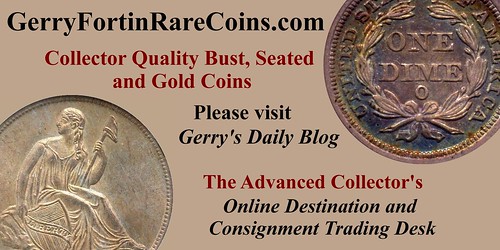
CHANGES TO U.S. PAPER MONEY PORTRAITURE
Coin World summarized the announcement in an April 20, 2016 article by Joe O'Donnell with a mockup of a Tubman $20. -Editor

The U.S. Treasury announced in a Wednesday afternoon press release that Harriet Tubman will indeed replace Andrew Jackson on the face of the $20 Federal Reserve note.
The Underground Railroad pioneer was the leading vote-getter in a 2015 poll sponsored by the Women on 20s campaign, which made headlines last year as it advocated for replacing Jackson with a woman.
Today's decision represents a change in direction for Treasury Secretary Jack Lew, who in June 2015 pegged the $10 FRN as the denomination that would don a notable woman's portrait.
"Since we began this process, we have heard overwhelming encouragement from Americans to look at notes beyond the $10," Lew wrote in a letter that accompanied the press release. "Based on this input, I have directed the Bureau of Engraving and Printing to accelerate plans for the redesign of the $20, $10, and $5 notes."
Lew said he anticipates that final concept designs for the new $20, $10 and $5 notes will all be unveiled in 2020 in conjunction with the 100th anniversary of the 19th Amendment, which granted women the right to vote.
Jackson became the target of Women on 20s as a president who was behind the mass relocation of Native Americans by way of what is commonly called the Trail of Tears.
Jackson will still have a spot on the $20 FRN. Lew said an image of him will appear on the back of the note along with a portrait of the White House.
Abraham Lincoln will continue to appear on the face of the $5 FRN, but the redesigned back of the note will depict historic events that have occurred at the Lincoln Memorial.
To read the complete Coin World article, see:
Harriet Tubman will replace
Andrew Jackson on $20 bill (http://www.coinworld.com/news/paper-money/2016/04/harriet-tubman-20-dollar-bill-andrew-jackson.html)
Treasury Secretary Jacob J. Lew on Wednesday announced the most sweeping and historically symbolic makeover of American currency in a century, proposing to replace the slaveholding Andrew Jackson on the $20 bill with Harriet Tubman, the former slave and abolitionist, and to add women and civil rights leaders to the $5 and $10 notes.
Mr. Lew may have reneged on a commitment he made last year to make a woman the face of the $10 bill, opting instead to keep Alexander Hamilton, to the delight of a fan base swollen with enthusiasm over a Broadway rap musical based on the life of the first Treasury secretary.
But the broader remaking of the nation’s paper currency, which President Obama welcomed on Wednesday, may well have captured a historical moment for a multicultural, multiethnic and multiracial nation moving contentiously through the early years of a new century.
Mr. Lew directed the Bureau of Engraving and Printing to hasten the redesign of the $20 and $5 notes at the same time. Subsequent production of the $10 bill would take precedence, though Mr. Lew said all three notes could be in wallets before 2030. The final decision on release is up to the Fed.
One wild card is that Mr. Lew and President Obama have just months left in office. But Mr. Lew expressed confidence that his successors would not veto the currency makeovers.
To read the complete New York Times article, see:
Harriet Tubman Ousts Andrew Jackson in
Change for a $20 (www.nytimes.com/2016/04/21/us/women-currency-treasury-harriet-tubman.html?_r=0)
Dick writes:
Replacing General Jackson with a portrait of Harriet Tubman is political correctness run amok. As one writer stated there is a single sentence about Tubman in Samuel Eliot Morison’s “The Oxford History of American People” while there are five pages on Andrew Jackson.
Placing a woman on our currency is an admirable move by the Treasury. However, a far better choice would be a Generic Woman – honoring ALL women.
General Jackson deserves to stay on the $20 bill to continue to be recognized as one of the great patriots in early American history.
... this also goes to the core of a broader debate: what is the best way to publicly acknowledge all of the facets of our history?
“The context is the ongoing debate over how history should be represented in public,” Foner said. “I approve of this. I think the best way to deal with it is to add, not necessarily subtract. The public recognition of history should represent the actual history. Including Harriet Tubman is more representative of the history of the United States.”
“In the south, I don’t think they should take down statues of Confederate leaders,” Foner continued. “They should put up statues of black congressmen and senators. It makes the public history more accurately reflect our entire history.”
Now the $20 bill literally represents two sides of our history — slave ownership and abolitionism.
To read the complete article, see:
Harriet Tubman just bumped Andrew Jackson from the $20 bill. Historian Eric Foner approves.
(www.washingtonpost.com/blogs/plum-line/wp/2016/04/20/harriet-tubman-just-bumped-andrew-jackson-from-the-20-bill-historian-eric-foner-approves/?tid=a_inl)
THE USUAL concern of an editorial page is government ineptitude or corruption, but it is also our occasional pleasant duty to call attention to cases of government competence — the most recent of which is Treasury Secretary Jack Lew’s proposed redesign of U.S. currency. In fact, “competent” is too weak an encomium for Mr. Lew’s elegant handling of a sensitive task — to include images of women and minorities on heretofore white-male-dominated paper money.
In responding to a groundswell that began with Internet-based petition drives to replace Andrew Jackson’s image on the $20 bill with that of a woman, Mr. Lew had to navigate all the treacherous crosscurrents that characterize identity politics in 21st-century America. He initially planned to meet the demand for a woman by replacing Alexander Hamilton on the $10 bill, which was due for a redesign anyway. When that met with resistance from Hamilton’s admirers — ranging from former Federal Reserve chairman Ben S. Bernanke to fans of the eponymous Broadway musical — Mr. Lew took their good arguments into account and pivoted to a wider, and even more inclusive, plan to modernize several bills, not just the $10 or the $20.
The hallmark of Mr. Lew’s plan is addition, not subtraction; to embroider ever more of the country’s complex history, and the characters who made it, into these most widely used of government documents — as opposed to purging them or dumbing them down. Harriet Tubman, the great leader of the Underground Railroad and hero of the Union intelligence effort during the Civil War, will take Andrew Jackson’s place on the front of the $20; she becomes the first woman so honored on paper currency in more than a century, and the first African American. However, Jackson’s image will be retained in a redesigned reverse side of the bill — due recognition of his pivotal presidency and military leadership and, perhaps, a conversation-starter about his darker side as a slaveholder and oppressor of Native Americans.
To read the complete article, see:
The Treasury’s brilliant plan to redesign U.S. currency
(www.washingtonpost.com/opinions/the-treasurys-brilliant-plan-to-redesign-us-currency/2016/04/21/0866c700-07d0-11e6-bdcb-0133da18418d_story.html)
Conservatives should be delighted that Harriet Tubman’s likeness will grace the $20 bill. She was a Republican, after all, and a pious Christian. And she routinely exercised her Second Amendment right to carry a gun, which she was ready to use against anyone who stood in her way — or any fugitive slave having second thoughts. On her long road to freedom, there was no turning back.
Tubman was born into slavery on Maryland’s Eastern Shore around 1822. She escaped to Philadelphia in 1849 but returned to the South more than a dozen times, risking life and liberty, to lead runaway slaves to freedom. Slave owners reportedly offered bounties of thousands of dollars for capturing the diminutive woman known on the grapevine as “Moses.”
“I was conductor of the Underground Railroad for eight years,” she said later in life, “and I can say what most conductors can’t say — I never ran my train off the track and I never lost a passenger.”
But that was just the beginning of Tubman’s heroic service. During the Civil War, she guided a team of Union scouts operating in the marshlands near present-day Beaufort, S.C. In 1863, she led a raid on plantations along the Combahee River that freed more than 750 slaves — becoming, apparently, the first woman to lead U.S. troops in an armed assault.
Later in life, she worked alongside Susan B. Anthony and others in the crusade for women’s suffrage. She died in 1913, frail yet still unbowed, having lived one of the greatest of American lives.
Is it political correctness and historical revisionism to put her defiant likeness in our pockets? Of course — and high time, too.
To read the complete article, see:
It matters who’s on the money, and Harriet Tubman fits the bill
(www.washingtonpost.com/opinions/it-matters-whos-on-the-money-and-harriet-tubman-fits-the-bill/2016/04/21/c819ef58-07f5-11e6-a12f-ea5aed7958dc_story.html)
Tubman’s story will not be the only new tale to be told on our future paper money. Lew also announced that the backs of the $5 and $10 notes will be redesigned as well, with the now familiar structures on the two notes (the Lincoln Memorial on the $5 note and the Treasury Building the $10 issue) retained but gaining scenes of historic events conducted in the name of liberty and freedom at both sites.
The back of the $5 note will show historical vignettes of the growing movement for equal rights for African Americans in the 20th century: Marian Anderson’s triumphal 1939 operatic performance in front of 75,000 people at the Lincoln Memorial after being denied a venue at one of the capital’s segregated concert halls; Martin Luther King’s stirring “I Have a Dream” speech in 1963 before a crowd of hundreds of thousands. A portrait of Abraham Lincoln, who preserved the Union and helped end slavery, will remain on the face of the note, the two sides meshing perfectly in telling a shared story.
Similarly, Alexander Hamilton, our first Treasury secretary and a financial genius, and the Treasury Building will remain on the $10 note, but the back will feature scenes like the March 1913 gathering at the Treasury facility of women’s suffrage advocates and a vignette honoring Lucretia Mott, Sojourner Truth, Susan B. Anthony, Elizabeth Cady Stanton and Alice Paul for their contributions to women’s suffrage.
Historical vignettes have largely disappeared from our paper money. Their return, with stirring new stories, should be exciting.
NEW PAPER MONEY DESIGNS TO DEPICT STIRRING STORIES OF FREEDOM, LIBERTY (www.coinworld.com/voices/bill-gibbs/2016/04/new_paper_money_desi.html)
I'll withhold judgement on the other proposed changes. I think showing famous events where the Lincoln Memorial was a backdrop is a great idea, adding life to an otherwise cold, classic depiction. A vista of the crowd at MLK's "I Have A Dream" speech could be inspiring. But attempting to acknowledge multiple events in one image could dilute the effect. Despite the expense perhaps a series of commemorative reverses would better meet the need.
And finally, in the life-imitates-art department, I'll end with an image of the first note in money artist J.S.G. Boggs' 1990s Women's Series, where he advocated putting women on our currency twenty years ago. His first pick? Harriet Tubman as a young girl.

Note to other editors in the numismatic and general press - find Boggs and interview him (he lives in Brandon, FL). He deserves some acknowledgement. Artists lead a tough existence, often dismissed and overlooked in their lifetimes, only to be lauded as visionaries long after their deaths. It would be interesting to hear his take on this week's announcements. -Editor
To read the origial Treasury Press release, see:
Treasury Secretary Lew Announces Front of New $20 to
Feature Harriet Tubman, Lays Out Plans for New $20, $10 and $5 (www.treasury.gov/press-center/press-releases/Pages/jl0436.aspx)
To watch the BBC News video, see:
Former slave to be face of US $20 bill
(www.bbc.com/news/world-us-canada-36099448)

THE 11-YEAR-OLD GIRL WHO WROTE TO THE PRESIDENT
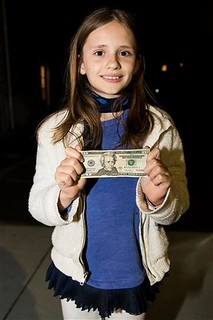 In a few years when Sofia gets her first chance to spend a redesigned $20 bill featuring Harriet Tubman, the Massachusetts fifth-grader can
take some extra pride in knowing the role she played in getting the first woman portrayed on U.S. paper currency in more than a century.
In a few years when Sofia gets her first chance to spend a redesigned $20 bill featuring Harriet Tubman, the Massachusetts fifth-grader can
take some extra pride in knowing the role she played in getting the first woman portrayed on U.S. paper currency in more than a century.
Sofia, whose family asked that her full name not be used, wrote a letter to President Barack Obama after noticing the lack of women on U.S. currency while working on a class project.
“It makes things feel fair,” Sofia said Thursday.
On Wednesday — her 11th birthday — she received phone calls from U.S. Treasury Secretary Jacob Lew and other officials informing her of the decision to put Tubman, an African-American abolitionist, on the front of the $20 bill and feature other women on other bills.
“If women do important things just like men, women should be on our currency too, and once that happens it’s going to be amazing,” Sofia said in an interview with the Associated Press at her Cambridge home.
Her letter to Obama in 2014 read in part: “I am writing to know why there aren’t more women on dollars/coins for the United States. I think there should be more women on the dollars/coins of the United States because if there were no women there wouldn’t be men.”
At the bottom of the letter, Sofia suggested a dozen names that could fit the bill, including Tubman’s.
Sofia did not hear back right away, but a few months later the family heard that Obama had referenced a letter from a “Massachusetts girl” in a speech and wondered if it was her. It turned out that it was, and in February 2015 a letter arrived from the White House from Obama thanking Sofia for writing to him “with such a good idea.” The women she suggested were an impressive group, “and I must say you’re pretty impressive too,” the letter stated.
Sofia’s proud mom, Kim, said her daughter is concerned about the world, “but I think the part of the story I like the best is that she really is just an average, typical little girl who noticed something that was unfair in the world and she decided to do something about it.”
Sofia said she does not have plans for politics herself in the future, and instead hopes to become a scientist. For now she is enjoying a heartfelt wish that has come true.
“I was really excited and to have it happen on my birthday, it was the best birthday present ever,” she said.
To read the complete article, see:
Girl who wrote Obama excited over Harriet
Tubman on $20 bill (http://krqe.com/2016/04/21/girl-who-wrote-obama-excited-over-harriet-tubman-on-20-bill/)
THE BOOK BAZARRE
BURNS NUMISMATIC LIBRARY DONATIONS SOUGHT
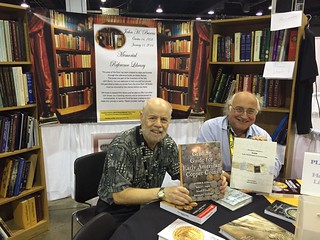 PAN has committed to continue with the traveling circuit of the John Burns Numismatic Reference Library. The next stop will be the Central
States Numismatic Society Convention at Shaumburg, IL on April 27 th – April 30 th . If you are planning to attend the coin show then please stop by
at the club row, tables K-L, and tell us what you think.
PAN has committed to continue with the traveling circuit of the John Burns Numismatic Reference Library. The next stop will be the Central
States Numismatic Society Convention at Shaumburg, IL on April 27 th – April 30 th . If you are planning to attend the coin show then please stop by
at the club row, tables K-L, and tell us what you think.
The library made its’ traveling debut at the ANA World’s Fair of Money last August. The support shown by the number of visitors browsing through the books was impressive. The idea is sound in that it provides collectors and dealers with a useful and convenient tool to have access to during a coin show.
If you are thinking about a book purchase, the library is a perfect chance to leaf through and decide if a particular book is something that you may want to own. If you are a dealer and forgot one of your reference books then you have an alternative. A collector may be on the fence about a particular purchase and can now have a look at rarity or information that can determine a thoughtful decision. A complete inventory list of the 200 books has now been created and can be accessed on the Burns Library page through the PAN website at http://pancoins.org/john-burns-memorial-reference-library/
Book donations are actively being sought. The list will determine the weak areas that need improvement and it is our hope that numismatists and bibliophiles come through to help. Book donations can be dropped off at the shows or can be mailed to PAN.
The library financial resources have now dwindled to the bare bones as a result of the planned Central States trip. PAN would like to keep the tires inflated for this worthy cause and would hope that you would consider a financial donation. The library will be set up at the PAN Spring Show, May 5-7 and next at the Gettysburg Coin Show, September 16 - 17. Where the library is able to go in the future is dependant on finances. The John Burns Memorial Reference Library is a fitting way to promote numismatic education in John’s honor and it is also a means to acknowledge and appreciate the donors that gave generously to help a friend.
To donate funds to the Burns library, see:
http://pancoins.org/donate-to-pan/
Send a check or ship books to:
PAN
1985 Lincoln Way
Suite 23 #225
White Oak, PA 15131
PAN AUCTION CLOSES MAY 6, 2016
 The Pennsylvania Association of Numismatists (PAN) is conducting an online auction that is live now. What is novel about this on-line
auction is that the lot viewing will be available at various coin shows up to the auction’s ending at 6:00pm May 6th at the PAN Spring Coin Show.
The Pennsylvania Association of Numismatists (PAN) is conducting an online auction that is live now. What is novel about this on-line
auction is that the lot viewing will be available at various coin shows up to the auction’s ending at 6:00pm May 6th at the PAN Spring Coin Show.
The Central States Numismatic Society Convention April 25th – May 1st in Schaumburg IL will be the next location where the PAN Auction Lots will be displayed. PAN will have a table at the K-L club section.
CoinZip.com is running the mechanics of the auction and donating their time to PAN. The 10% buyer’s fee will all go directly to PAN. There is no seller’s fee. The interest has been active with a lot of collectors curious about the idea. All of the lots are affordable collector type of numismatic items. The lots include a wide variety that will have a broad appeal. New lots are placed weekly. Auction lots can be accessed from the PAN website Auction Page or on the CoinZip.com website. Click the PANAuctions Icon.
PAN invites you to have a look and bid or place some items in the auction. Lots will be set up for viewing at the PAN May 5 th – 7 th Spring Coin Show. The bidding ends at 6:00pm Friday. Winning lot pick up will be available on Saturday for those that do not want to pay for postage.
Some of the interesting lots include:
- 1927 Thomas Elder Auction Sale that includes a pamphlet, Collector’s Notes, produced by Elder.
- Signed Breen’s Encyclopedia that includes three Breen checks, one to his wife Miriam.
- Large German Porcelain medallion, 1923.
- 1837 Marietta PA Store Scrip.
- 1862 $5 Virginia Treasury Note.
- 1826 nicely toned Bust Half.
Conder Token: 1794 Glorious First of June Farthing
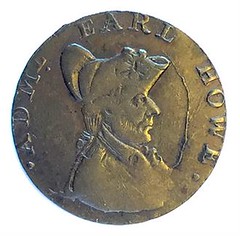
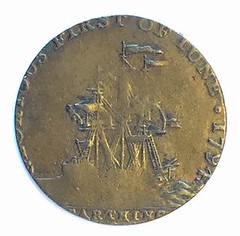
1794 1 farthing
Obverse
Hampshire, England
Admiral Earl Howe portrait facing right
NOTE: many different varieties exist.
DH#102A Lettering: .ADML. EARL HOWE.
Reverse Sail Ship
Lettering:
GLORIOUS FIRST OF JUNE·1794·
FARTHING Edge: plain
To read the complete lot description, see:
http://www.go2coinauctions.com/Listing/Details/876788/1794-Farthing-England
Joseph Horne Company Charge Coin
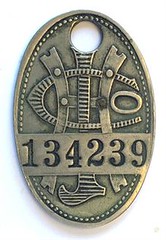
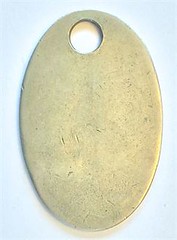
Joseph Horne Company Charge Coin
Before plastic credit cards, fine department stores would extend credit on account and issue coins designed to fit on a key chain or to be tucked away in a women’s purse so that she could go shopping without cash. The charge coins were issued by upscale establishments through the 1940s until charge-a-plates and credit cards took over.
It was often referred to simply as Joseph Horne's or Horne's, was an iconic, regional department store chain based in Pittsburgh, Pennsylvania. The store was one of the oldest in the country being founded on February 22, 1849, but was often overlooked as it maintained only a regional presence. The chain ceased operations in 1994 after being merged with the Lazarus division of Federated Department Stores.
This charge coin would make a lovely Mother's Day gift for Grand Mom. You can buy a nice chain and place in a box. The auction ends on Friday with pick-up on Saturday ready for delivery on Sunday, Mother's Day.
To read the complete lot description, see:
Joseph Horne Company Charge Coin
(www.go2coinauctions.com/Listing/Details/876442/Joseph-Horne-Company-Charge-Coin)
WALTER BREENS COMPLETE ENCYCLOPEDIA
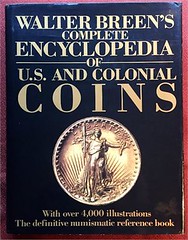
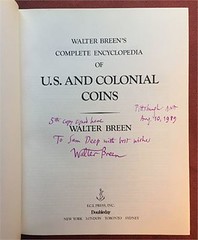
Signed Copy - WALTER BREEN'S COMPLETE ENCYCLOPEDIA OF U.S. AND COLONIAL COINS
Published by FCI/Doubleday, New York, 1988
754 pages over 4,000 black-and-white photographs of coins with accompanying descriptive captions/passages.
Walter Breen was one of the most brilliant and accomplished numismatists of his time. His life also had a very dark and controversial side at the other end of the spectrum. For those that may not know he spent his final days in prison convicted of child molestation and eventually dying of cancer. His life has reemerged lately through a recent CoinWeek article "Confronting Breen" by Charles Morgan and Hubert Walker. Walter again has come up in digital conversations in The E-Sylum.
This auction lot includes his most well known reference book. It is signed by Walter Breen to the 1989 ANA Convention Chairman Sam Deep.
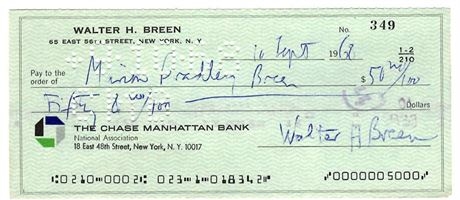
This auction lot also includes 3 interesting Walter Breen cancelled checks. The first is a September 1968 check to his wife and science fiction writer, Marion Zimmer Bradley (June 3, 1930 – September 25, 1999).
The second check is made out to Volunteers of America on September 19, 1968.
The last check may be numismatic related made out to Collectors Gallery ??? More research would need to be done on this one.
To read the complete lot description, see:
Signed Copy - WALTER BREENS
COMPLETE ENCYCLOPEDIA (www.go2coinauctions.com/Listing/Details/172714/Signed-Copy-WALTER-BREENS-COMPLETE-ENCYCLOPEDIA)
1837 Store Scrip, Marietta, Pennsylvania
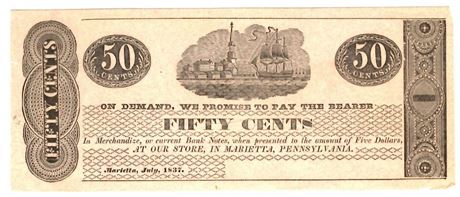
50 Cent Store Scrip, Marietta, Pennsylvania
A piece of Marietta, Pennsylvania 1837 Store Scrip redeemable in current Bank Notes
July 1837
To read the complete lot description, see:
50 Cent 1837 Store Scrip,
Marietta, Pennsylvania (www.go2coinauctions.com/Listing/Details/172750/50-Cent-1837-Store-Scrip-Marietta-Pennsylvania)
1923 Large German Porcelain Medallion
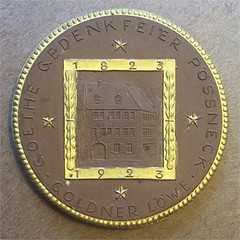

1923 Large German Porcelain Medallion Goethe Gedenkfeier Pössneck Goldner Löwe
Material: Brown Porcelain with Gold decoration Diameter: approx. 51 mm Produced by: Meissen
Obverse: Goethe Memorial, Goldner Lion 1823 - 1923 Goethe gedenkfeier possneck goldner lowe, Goethe Commemoration possneck Goldner Lowe
Reverse: Einig unveruckt zusammen wandernd leuchten ewig sie herab die sterne. Rough Translation: Agree unpublished moves along migratory lights shine forever down the stars.
To read the complete lot description, see:
1923 Large German Porcelain
Madallion (www.go2coinauctions.com/Listing/Details/172795/1923-Large-German-Porcelain-Madallion)
1826 O-118 Capped Bust Half Dollar
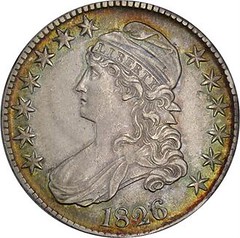

To read the complete lot description, see:
1826 O-118 Capped Bust Half Dollar
(www.go2coinauctions.com/Listing/Details/172696/1826-O118-Capped-Bust-Half-Dollar)
Thomas Elder Auction Catalog, 1927
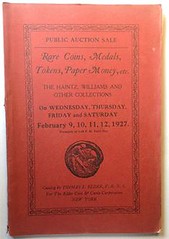
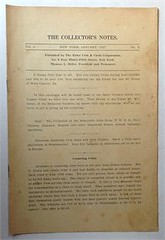
Thomas Elder Public Auction Sale
Haintz, Williams, and other collections
February 9, 10, 11, 12, 1927
Very nice copy with a few prices noted. This lot also includes Thomas Elder's pamphlet "The Collectors Notes" Vol. 2, No. 2, Jan. 1927. It is 7 pages and in very good condition with no tears and slight foxing.
To read the complete lot description, see:
Thomas Elder Auction Catalog, 1927
(www.go2coinauctions.com/Listing/Details/497403/Thomas-Elder-Auction-Catalog-1927)
To view the complete auction listing, see:
http://www.go2coinauctions.com/Browse?Seller=PAN-Auctions

SELECTIONS FROM HERITAGE NEWMAN INTERNET PART 1 SALE
Newman Collection Obsolete Currency Does Not Live by Banknotes Alone
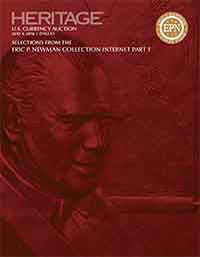 The first in a series of Internet-only currency auctions is available for preview and bidding on the Heritage Auctions website. This sale
features Colonial, Continental, Obsolete, and Confederate currency as well as modern United States Small Size and Error notes and closes on
Wednesday, May 4, 2016. The American Obsolete Currency offered in the sale represents many periods, styles, payable obligations, genres and
locations. Though intricately engraved banknotes and proofs often artistically overshadow the private scrip notes, there is no denying their rustic
charm and inherent history reflecting the period and purpose of issuance.
The first in a series of Internet-only currency auctions is available for preview and bidding on the Heritage Auctions website. This sale
features Colonial, Continental, Obsolete, and Confederate currency as well as modern United States Small Size and Error notes and closes on
Wednesday, May 4, 2016. The American Obsolete Currency offered in the sale represents many periods, styles, payable obligations, genres and
locations. Though intricately engraved banknotes and proofs often artistically overshadow the private scrip notes, there is no denying their rustic
charm and inherent history reflecting the period and purpose of issuance.
Featured below are several of these private scrip notes that demonstrate Eric’s ongoing study in the fascinating Obsolete Currency field.
Lot 86314: 1777 Winchester Private Scrip
The May 5, 1777 Winchester, Virginia James Doudas private note is considered unique; it is plated in both The Early Paper Money of America
and the Jones & Littlefield Virginia reference. May 5, 1777 was a date of issuance of Virginia Treasury bills, and the date of this
note is likely not a coincidence.

Winchester, in Virginia - F. James Doudas "I promise to pay to the Bearer" May 5, 1777 3 Pence Newman page 448, Jones & Littlefield PW70-04. PCGS Very Fine 20 Apparent.
This Revolutionary War period private scrip note is considered unique, and it is the only example we have encountered. It is both the Newman plate note, illustrated on page 448 of the 5th edition, and the Jones & Littlefield plate note in the Virginia Obsolete Currency book. It has an interesting series date that coincides directly with the date of the handwritten May 5, 1777 notes. Printed on laid paper with ornamental borders. At the left end are planetary signs. The obligation is across with "3d." in a cartouche at lower left.
Eric Schena writes:
I have never seen one of those outside of the Jones Littlefield book. That is the rarest of the rare!
To read the complete lot description see:
http://currency.ha.com/itm/colonial-notes/winchester-%20in-virginia-%20f-james-%20doudas-i-%20promise-to-%20pay-to-%20the-bearer-%20may-5-%201777-3-%20pence-newman-%20page-448-%20jones-andamp-%20little/a/241618-86314.s?ic4=GalleryView-%20ShortDescription-071515
Lot 86385: City of Mobile $3
The City of Mobile, Alabama $3 note is an intricate, intaglio engraved municipal scrip note from the Reconstruction period. The vignettes are an unusual hybrid of Union victory and the earlier Southern agrarian economy (sugar cane harvesting and wagon loading).
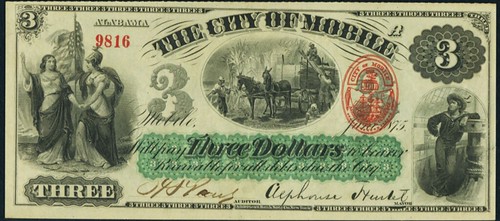
Mobile, AL - City of Mobile $3 June 1875 Rosene 187E-3. PCGS Choice About New 58.
A striking, bright and vivid Reconstruction era note from Mobile printed by the American Bank Note Co. The oval center vignette shows sugar cane being loaded onto a wagon. Outstanding imagery is exemplified by a dynamic allegory at the left. A female representing Peace (note the two crossed swords on the ground) greets Athena, representing America with the Old Glory. At the right end, a sailor leans on a capstan. There is a large green protector and red overstamp. The back is all green with CITY OF MOBILE at the center. Justifiably, this handsome series is well appreciated by collectors who recognize its rarity and beauty.
To read the complete lot description see:
http://currency.ha.com/itm/obsolete-banknotes/mobile-%20al-city-%20of-mobile-%203-june-%201875-%20rosene-187e-%203-pcgs-%20choice-about-%20new-58/a/241618-%2086385.s?ic4=GalleryView-%20Thumbnail-071515
Lot 86678: Steamer Natchez 50 Cents
Unusual payables frequently make a scrip note intriguing, and the Civil War change notes often served numerous emergency needs. The John Hawkins, Steamer Natchez 50 cents is attributed to New Orleans, though no location is engraved on the note. While the condition is not exceptional, its historical character is certainly top-notch.
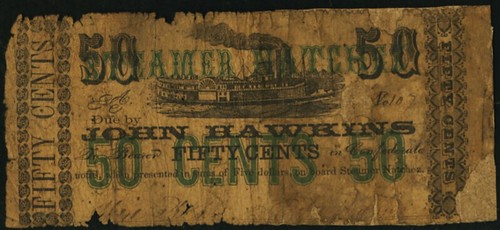
(New Orleans, LA) - John Hawkins, Steamer Natchez 50 Cents Undated (Ca. 1862). PCGS Very Good 8 Apparent.
This certainly is among the greatest Confederate era scrip note titles and payable types we have ever encountered. Technically, this is a "floating issuer" as it was payable in "Confederate Notes ... on board Steamer Natchez." There is no city listed, but its style most strongly suggests the note was printed in New Orleans, where several printers used this style. In Wendell Wolka's Paper Money magazine article "Enemy at the Gates" The Fall of New Orleans and its Effect on Scrip Issuers in the City, this issuer is on the compiled listing of New Orleans scrip notes used at that time. It is reasonable to classify this as a multi-state type due to its unusual obligation, but its New Orleans origin is logical.
There were many incarnations of the Steamer Natchez. This note was used on the sixth boat, which operated during the War and transported Confederate troops but was burned near Honey Island, possibly to keep it out of Union hands. The bold vignette of a sidewheel steamer traveling eastward is at top center. STEAMER NATCHEZ in green is over the smokestacks and the flanking "50" numerals. Text and obligations are below with "50 CENTS 50" in green. Cartouches at the ends show the textual denomination. The obligation, as we noted previously, is under the title. This note experienced extensive circulation...
To read the complete lot description see:
http://currency.ha.com/itm/obsolete-banknotes/-%20new-orleans-%20la-john-%20hawkins-steamer-%20natchez-50-%20cents-undated-%20ca-1862-%20pcgs-very-%20good-8-%20apparent/a/241618-%2086678.s?ic4=GalleryView-ShortDescription-%20071515
Lot 86908: Fort Edward, NY - Sackride & Willoughby
The lack of currency in the War of 1812 era necessitated the creation of many private scrip notes, some of which continued to be denominated in the English pence-shillings system. Several upstate New York bills fit this criterion and are quite charming like the 2 shillings issued by Sackride & Willoughby in Fort Edward, New York.


Fort Edward, NY - Sackride & Willoughby at our Store in Fort-Edward 2 Shillings November 29, 1814. PCGS Very Fine 20 Apparent.
A shilling-denominated note from this extremely rare issuer. More elaborate than the smaller denomination above. The double line border is still on three sides, but the left end shows border cuts and type ornaments. The denomination is across the top as "2 shillings," and is completely spelled out on the back of the note. There are only some "Small Edge Tears; Minor Stains" noted. A very charming note and a great rarity.
To read the complete lot description see:
http://currency.ha.com/itm/obsolete-banknotes/fort-%20edward-ny-%20sackride-andamp-%20willoughby-at-%20our-store-%20in-fort-%20edward-2-%20shillings-november-%2029-1814-%20pcgs-very-%20fine-%2020-apparent/a/241618-%2086908.s?ic4=GalleryView-ShortDescription-%20071515
Lot 87160: Provo City, UT - W. H. Freshwater
Utah and Mormon issued currency notes continue to be well regarded for their history. Several, possibly unique, discovery notes are
featured and published for the first time in Newman Internet Part 1. Some issuers are known only from the Mormon Church Archives. The W. H.
Freshwater, Provo City, Utah Territory 10 cents note might be unique and is outstanding, in Gem Condition.
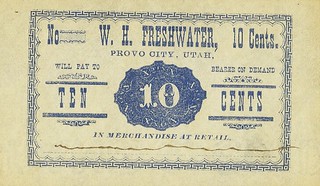
Provo City, UT - W. H. Freshwater 10 Cents Undated Rust UNL, Nyholm 264var. Remainder.
The inspired selection of Provo, Utah Territory discovery notes from the Newman Collection, covering two separate sale dates, continues with this newly published example. A 25 cents small format Freshwater note from this series is illustrated in Nyholm with a cancellation line in the signature area. Printed on white paper in all blue with pattern bordering all around. The title is at the top, an outlined "10" die is at the center flanked by TEN and CENTS between horizontal lines. Under the counter is the payable "In Merchandise at Retail." Not numbered or signed and "Pen Cancelled," as noted, through the long signature block. A stunning and nearly perfect note.
To read the complete lot description see:
http://currency.ha.com/itm/obsolete-banknotes/provo-%20city-ut-%20w-h-%20freshwater-10-%20cents-%20undated-rust-%20unl-nyholm-%20264var-remainder-%20pcgs-gem-%20new-66ppq/a/241618-%2087160.s?ic4=GalleryView-ShortDescription-%20071515
To view the complete preview of Selections from The Eric P. Newman Collection Internet Part 1, please click below: 2016 May 4 Selections from the Eric P. Newman Collection Part I Currency Internet Auction - Dallas #241618 (http://currency.ha.com/c/auction-home.zx?redirectOk=1&saleNo=241618&type=surl-241618)
THE BOOK BAZARRE
QUERY: FAZL-TARIN COLUMBIAN EXPO MEDAL INFO SOUGHT
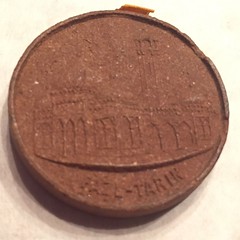
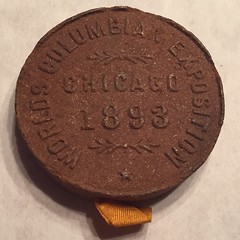
I recently purchased this Columbian Exposition medal and I'm wondering if any of your readers can shed some light on its origin. It appears to be crudely pressed from a wooden fiber composition and is approximately 37 mm in diameter. Eglit lists this as #244 and erroneously calls it "Tazl-Tarin" when it actually reads "Fazl-Tarin". He describes the indistinct building on the obverse as an Indian Temple. The piece was made with a small ribbon imbedded into the rim for suspension as you can see.
I'm guessing that it may actually picture a structure from the Exposition, perhaps from the Ethnic People's display at the Columbian Exposition. I have owned one other of these over 20 years ago and have never seen another. Can anyone share their knowledge on its history?
THE GEORGE W. LA BORDE COLLECTION OF ROMAN AUREI
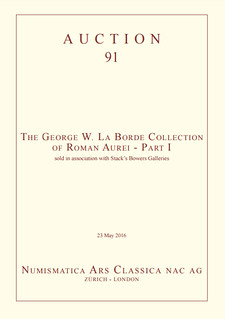 After meeting in London in 2005, by chance and for a few minutes only, an epistolary relationship developed between George La Borde and
myself. It took several years before we met in person again, but visiting him and his wife in Calgary has since become a regular pleasure for my wife
and myself. I have been very privileged, over the past decade, to assist him in forming his coin collection.
After meeting in London in 2005, by chance and for a few minutes only, an epistolary relationship developed between George La Borde and
myself. It took several years before we met in person again, but visiting him and his wife in Calgary has since become a regular pleasure for my wife
and myself. I have been very privileged, over the past decade, to assist him in forming his coin collection.
George named his oil-exploration company Athena Resources Ltd., with a Greek coin in mind. He understood that ancient coins and engraved gems allowed him to possess antiquities in the rarest and finest condition, illustrating the lives and the monuments of the ancients. And they are neither fragile nor space consuming, which is certainly a matter to consider when a collector acquires hundreds of artefacts.
My role of advisor was notably to help George avoid mistakes when he started to collect, and to invest very significant sums of money in a market of which he did not necessarily know all the rules. A wise businessman, he knew that an advisor could help him reach the pinnacle of collecting, and be as successful at this as he had been in his own field. Nevertheless, of course, I had to understand and respect his taste and interests, which is why – for example – some emperors are represented more often than others, and why there is a good series of reverses with Hercules.
 George benefited from my experience. It is the task of the advisor to have seen and to see, and it was my duty to inquire and to answer
George’s questions – even the questions that he did not know he had. Collectors tend not to like making mistakes, especially if it concerns buying
coins at tens or hundreds of thousands of dollars each. Having been involved in the coin market since 1992, it could be said that my own earlier
mistakes are put to profit by my clients of today!
George benefited from my experience. It is the task of the advisor to have seen and to see, and it was my duty to inquire and to answer
George’s questions – even the questions that he did not know he had. Collectors tend not to like making mistakes, especially if it concerns buying
coins at tens or hundreds of thousands of dollars each. Having been involved in the coin market since 1992, it could be said that my own earlier
mistakes are put to profit by my clients of today!
I often recommended against buying a coin, when I knew that a nicer example could be found in the future, or if I was aware of potential issues (condition or provenance). Also, I was occasionally able to add useful comments on the rarity or importance of a coin, and such was the case with an aureus of Faustina Minor, sold in the Gemini auction of 2006, which will be sold in the second part of the collection: though it had no provenance indicated on the catalogue, I was able to inform George that it came from the collection of Don Manuel Vidal Quadras Y Ramón (1818-1894), which the Paris dealer Etienne Bourgey sold at auction in December 1913.
I was also able to help George to decide the amount at which to bid, based on inside knowledge of who the seller is, and whether competitor-collectors intended to bid or not. I was hired to protect not only George’s interests, by helping him build the best collection possible considering both his means and the material available, but also for future generations – by trying to build a group that will be as valuable as possible when the time comes to resell it. Some coins, for one reason or another, may be overpriced. Other coins, although nice, could be found in better condition. Coins that do not attract the eye may be worth acquiring for their rarity.
Paying attention to the provenances, doing historical and comparative research, being informed early of upcoming auctions as well as collections available by private treaty, are all elements of what I, as an advisor, offered to George, and they are time-consuming, contact based, and require travelling, all of which freed up the time of an active businessman such as George and allowed him to focus on his work.
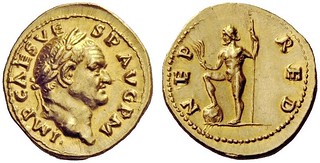 A collector, when purchasing a precious item, wants to be certain that he will be able to resell it: though not necessarily an investment
per se, the collectable remains an asset. In the last few years, provenance has become ever more important. Fortunately, I was able to foresee this
event, and I advised George to pay more attention to coins with a good pedigree.
A collector, when purchasing a precious item, wants to be certain that he will be able to resell it: though not necessarily an investment
per se, the collectable remains an asset. In the last few years, provenance has become ever more important. Fortunately, I was able to foresee this
event, and I advised George to pay more attention to coins with a good pedigree.
This does not mean that a coin without known provenance should be completely discounted, but its price should reflect the lack of established history. In fact, too few focus enough on the fact that « no provenance » means « no known provenance », and not necessarily that there is anything problematic about the piece. Take the aureus of Pertinax with Providence on the reverse: this coin is rare but far from unique, with some 125 recorded specimens; therefore, it is impossible to identify an example in an old catalogue unless it was reproduced. In addition, a good provenance adds value to an item: if it were not for its provenance, why would Jackie Kennedy-Onassis’ simulated pearl necklace have sold for over 200’000 dollars?
George favoured the view that his advisor should be independent. While acting for George, I was privileged to have the freedom to look only for the best coins. Though coins were issued as multiples, and are on the whole rather common, many of them are very rare and “not everyone can own rarities”.
Having money is not sufficient: a collector must also have patience and luck. George also had to be aware when an opportunity arose, and make sure not to miss his chance – and this is where an advisor offers valuable guidance. The 20th and 21st centuries have seen on offer major collections, such as those of Leo Biaggi, Charles Gillet, Athos Moretti and Claude Vaudecrane. I am proud to have helped to form George La Borde’s collection of Roman aurei – which I hope you will appreciate too.
Hadrien adds:
Because the collection is so nice, NAC, Stack's Bowers and I thought it deserved a special catalogue - with especially lengthy historical notes for most coins, with clear provenances (collectors' full names and life-dates), and with biographies of the main collectors in the end, so that it can become a reference-catalogue such as those great ones of the past (Ponton d'Amécourt, Montagu, Ryan, Platt-Hall, Perfectionist, etc.).
Of course I will be at the sale, offering my services to whoever wishes to bid but cannot do it in person.
To visit the Ars Classica web site, see:
www.arsclassicacoins.com
To download the complete auction catalog, see:
www.arsclassicacoins.com/wp-content/uploads/2016/04/Numismatica_Asta_n91_LR.pdf
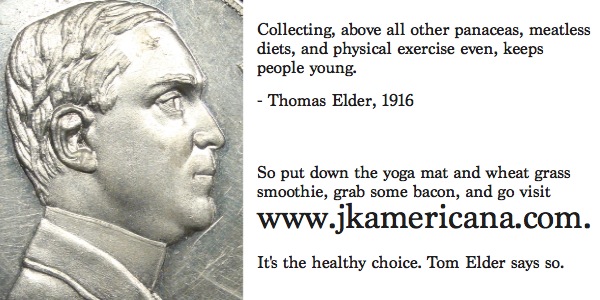
A PORTRAIT OF ANTINOUS, IN TWO PARTS
IF IT’S BAROQUE, SOMEONE SHOULD FIX IT!
Truer words could not be said by someone with a passion for ancient history, especially when the baroque takes over the ancient. Such is the case with a Roman Bust of Antinous in the collection of the Museo Nazionale Romano, Palazzo Altemps, in Rome. After the original ancient Roman face was broken at some unknown time, the bust received a “new” baroque-style face that was added by the mid-18th century. To many viewers, it is apparent that the face does not match the style of the rest of the bust and is a restoration added later. But then what happened to the original face?
The answer can be found in a new exhibition titled A Portrait of Antinous, in Two Parts, at the Art Institute of Chicago that opened on April 2, 2016. Loans from the American Numismatic Society help introduce Antinous—the Greek youth and companion of Roman emperor Hadrian, who mysteriously drowned in the Nile River in A.D. 130—and his enduring interest throughout history. The ANS loans include four bronze coins of Antinous and a 1711 book from the Harry W. Bass, Jr. Library. The coins demonstrate the same iconographic features that were likely inspired by sculptures of the same type of Antinous: broad shoulders, bare chest, and lush, curly hair.
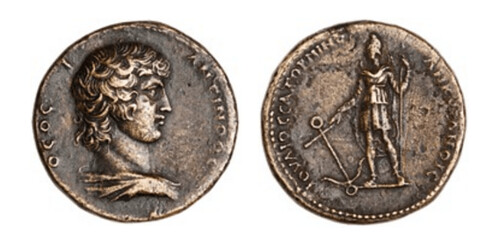
The show brings together years of research that took place to determine whether or not the Art Institute of Chicago’s Fragment of a Portrait Head of Antinous was the original face of the Bust of Antinous (inv. no. 8620) that belongs to the Palazzo Altemps museum, a suggestion first put forth by W. Raymond Johnson, Egyptologist at the University of Chicago. Since the “new” face that the Palazzo Altemps bust received is part of the sculpture’s history, it could not be removed, and added to the challenges of understanding if, and how, the Art Institute’s fragment might have fit. But—Spoiler Alert!—it did!
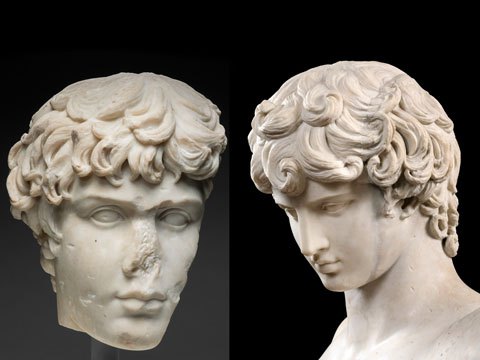
This conclusion, and the years of research that led to it, are the focus of the exhibition. Modern 3D printing technology was used to create a mold from which a plaster replica was made in order for the team to effectively demonstrate that the two parts were in fact originally part of one ancient bust. The show is centered around these two parts: the fragment of a portrait head from the Art Institute and the bust from the Palazzo Altemps, which are displayed together along with the full-scale plaster cast reconstruction that gives the impression of its original appearance in antiquity.
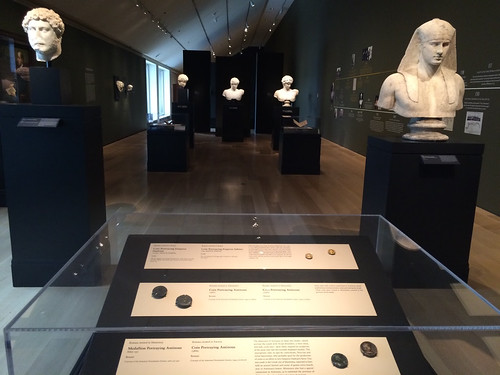
To read the complete article, see:
IF IT’S BAROQUE, SOMEONE SHOULD FIX IT! (www.anspocketchange.org/baroque/)
WOMEN ON BYZANTINE GOLD COINS
Rule by women was less common, but not unheard of in the Byzantine Empire—or in the ancient world for that matter! As such, ancient coins frequently depicted women. The National Numismatic Collection holds several Byzantine coins featuring images of women. Emperor Justin II's coins show him and his wife, Sophia. Mary, the mother of Christ, is a common icon on Byzantine coins. The women rulers of Byzantium left lasting impressions (get it?) on the coins of the empire, but two women left particularly strong legacies in the wake of their rule. Irene and Theodora were two of the most (in)famous ladies to take the throne. Their political and religious actions caused drastic movement in the empire (and their family dramas are worthy of their own HBO show).
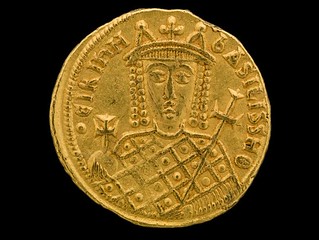
Empress Irene, Solidus coin, Constantinople, 792 – 802
Irene married into her position in 769 A.D. when she wed the emperor Leo IV. Originally from Athens, Irene brought her entourage with her to Byzantium. Many of her siblings married into the Byzantine court, further solidifying her familial position as imperial elite. After the death of her husband in 780, Irene became regent and co-emperor with their 10-year-old son, Constantine VI, and took over political affairs of the empire.
Irene's powerful reign bred anger and resentment in Constantine. Thanks in large part to military resistance against the empress, Constantine was eventually able to attain sole rule in 790. But that did not stop the ambitious Irene. Two years later, she returned both to court and to her position as co-emperor. By 797 she had incited a conspiracy against Constantine. Irene had her son blinded and imprisoned. (That even makes Cersei Lannister from Game of Thrones look like a healthy mother figure.) For five more years, Irene reigned as emperor—that’s basileus for you Greek scholars—over Byzantium.

Empress Theodora, Solidus coin, Constantinople, 1055 -1056
Unlike Irene, Theodora was born into the imperial line— as daughter to Emperor Constantine VIII. Her position as a daughter of the emperor should have ensured an early political marriage, but when her father betrothed her to Romanos (a married man) she refused. Her sister, Zoe, was instead presented as a second-choice wife. Romanos and Zoe married in 1028. Zoe remained deeply bitter toward her sister for being her father's first choice for the marriage and used her power to incite rumors about Theodora. Accused in conspiracy against Zoe, Theodora was confined to a monastery where she remained for 13 years. Talk about family drama.
To read the complete article, see:
Women in gold: Powerful empresses on Byzantium
coins (http://americanhistory.si.edu/blog/women-gold-powerful-empresses-byzantium-coins)
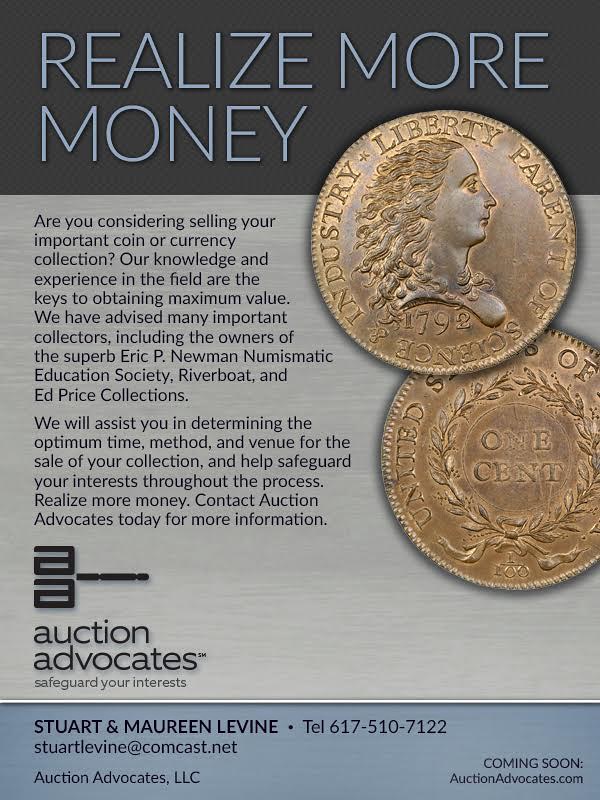
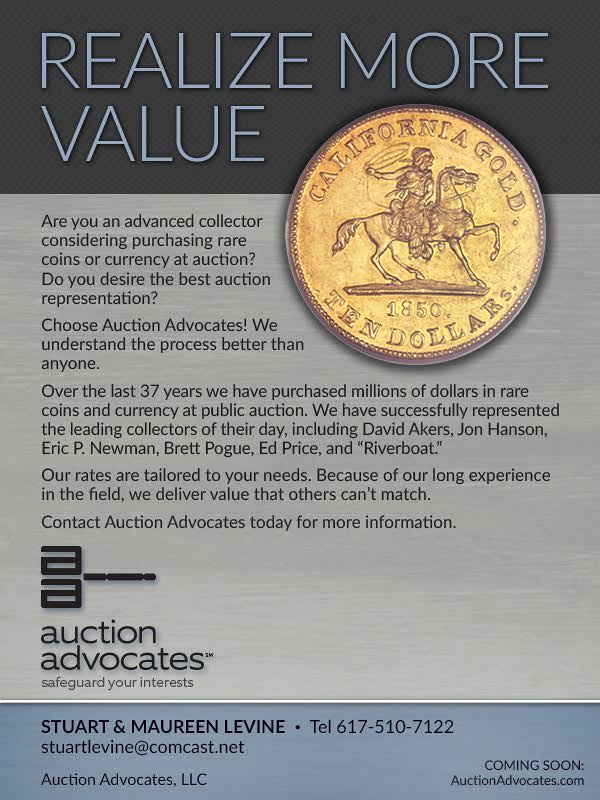
THE CASE OF THE LION COUNTERMARK
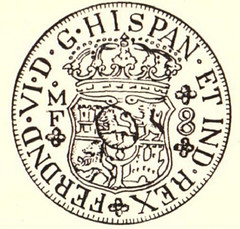 Dramatis Personae: Sherlock Holmes and his friend, Dr. Watson. Scene: Sherlock Holmes’ study in London.
Dramatis Personae: Sherlock Holmes and his friend, Dr. Watson. Scene: Sherlock Holmes’ study in London.
(Sherlock holds in one hand a registered package that has been opened and in the other hand, a large 8 reales silver coin of the Mexico mint countermarked with a very aristocratic looking lion rampant. )
SHERLOCK: Watson, for the first time, we have at last a “corpus delicti” which we may examine minutely at our leisure and which will give us a definite clue to this most interesting and extremely puzzling case. I am confident however that this coin never saw the sunshine of Nicaragua in spite of what both Heiss, Herera and others say about it. In the first place, why should anyone place another “Spanish” royal lion where two honest-to-goodness royal “Spanish” lions are already ramping their way in the ether towards the west? The coin is already legal tender and how could another royal SPANISH (?) lion add to its reliability and acceptability in Nicaragua? Hand me my magnifying glass so that I can examine that intruder more minutely. . . Why, Watson, this does not look like a Spanish lion! It looks to me like one of those lions with a slick glossy coat and curling mane and a tail with its tassel curved backward and not forward as in the case of its two Spanish companions — just like those lions that roamed around in the marshes of the Low Countries! Yes, very much like that Brabant lion in an oval countermark on that silver crown of
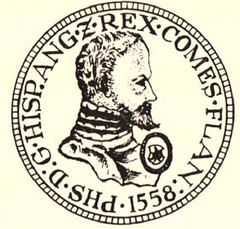 Philip the Second dated 1558 which we purchased last month in Piccadilly.
Philip the Second dated 1558 which we purchased last month in Piccadilly.
WATSON: Yes, remarkably like that old 16th century countermark, but, Sherlock, the “dos Mundos” is an 18th century coin?
SHERLOCK: I do not think that any colonial die sinker could have modeled such a well engraved lion. Of course, the two Gils of the Mexican Mint could have had a hand in it as they were about the best colonial engravers that Spain ever sent to her far-away colonial mints. No, Watson, unless they were taking a vacation, they never would have left the Mexican mint even for a couple of months as there was no mint in Nicaragua at that time and what enjoyment would there be for a master engraver like Gil to spend a vacation where there was no mint in which he could wander around. You know, Watson, even an old master may sometimes be a victim of mistaken judgment and of excessive enthusiasm. Take Herera, that grand old man. In his El Duro he ascribed three duros to a non-existing Nicaragua mint, coins which, I believe, are now recognized as being of South and not of Central American provenance and their NR is not NICA-RAGUA but Nuevo Reino! Could he not have been mistaken when, following Heiss, he ascribed the lion duro to Nicaragua?
WATSON: But, Sherlock, was there not a medal or token struck for but probably not in Leon, Nicaragua, which shows clearly a lion rampant on the reverse?
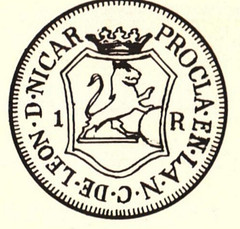 SHERLOCK: Yes, Watson, a lion, yes, a lion, and a ramping lion at that, but let us take it out of my cabinet and examine it closely. You
will note, dear Watson, that in the Leon coin the lion does ramp but it ramps on a plank and is pushing a huge ball from the plank into the blue,
piratical Caribbean Sea. Furthermore, he does not ramp towards the west as all respectable Iberian lions usually ramp but undoubtedly towards the
east. Therefore, the lion of this 8 reales, if we are to believe in heraldry, is definitely not the ball-pushing lion of “la noble ciudad de Leon” in
Nicaragua and is therefore not from the capital city of Nicaragua. That, Watson, is the “quid, ” finally and definitely solved. I think that we may
now state that the lion countermark never saw the skies of Nicaragua in spite of what Heiss, Herera and other famous cataloguers have said.
Furthermore, I would wager that the engraver of the die for the countermark never left Europe and never saw any overseas colony.
SHERLOCK: Yes, Watson, a lion, yes, a lion, and a ramping lion at that, but let us take it out of my cabinet and examine it closely. You
will note, dear Watson, that in the Leon coin the lion does ramp but it ramps on a plank and is pushing a huge ball from the plank into the blue,
piratical Caribbean Sea. Furthermore, he does not ramp towards the west as all respectable Iberian lions usually ramp but undoubtedly towards the
east. Therefore, the lion of this 8 reales, if we are to believe in heraldry, is definitely not the ball-pushing lion of “la noble ciudad de Leon” in
Nicaragua and is therefore not from the capital city of Nicaragua. That, Watson, is the “quid, ” finally and definitely solved. I think that we may
now state that the lion countermark never saw the skies of Nicaragua in spite of what Heiss, Herera and other famous cataloguers have said.
Furthermore, I would wager that the engraver of the die for the countermark never left Europe and never saw any overseas colony.
WATSON: But, Sherlock, how does this help us? We have not yet solved the problem of where the coin does come from.
To read the complete article, see:
The Case of the Lion Countermark (1953)
(http://fourthgarrideb.com/2016/04/the-case-of-the-lion-countermark-1951/)
THE 1902 TIENTSIN PROVISIONAL GOVERNMENT MEDAL
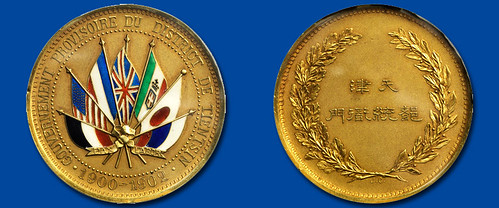
Continuing our recap of the Stack’s Bowers and Ponterio April Hong Kong Showcase Auction we feature today a gold medal from a pivotal moment in Chinese history. This gold medal brought amazing results, realizing $47,800 and surpassing the high estimate.
The Boxers seized the city of Tientsin in June 1900, and the Eight Nation Alliance (Germany, United States of America, France, United Kingdom, Italy, Japan, Russia and Austria-Hungary) recaptured the city on July 14th. Two weeks later the Alliance formed a provisional government on July 30th. For nearly two years the provisional government exerted military control over the city of Tientsin and the surrounding area. Toward the end of the spring of 1902, Governor Yuan Shih-kai of Chihli began talks to return control of the city and its environs to the Qing government.
Tientsin Tutung Yamen ceased to be on August 15th, but during its tenure it produced gold and silver medals, with the gold examples only presented to the foreign dignitaries of the provisional government. This medal is of great historical importance, clearly representing an international effort to stabilize the rapidly deteriorating control of the Qing dynasty. Only a small number of these gold medals are extant today, with most other examples impaired in some capacity. The piece presented here is absolutely stunning, with beautiful luster, pristine enamel on the nation's flags and choice honeycomb gold coloration. It is truly a world class example by any measure, and worthy of inclusion in the most advanced collection.
The obverse design features an impressive vexillogic display (left to right, Germany, the United States of America, France, Great Britain, the Kingdom of Italy, Japan and Russia). Just below the flags appears a banner stating: “PAX LABOR.” The outer French inscription states “Provisional Government of the District of Tientsin,” with the dates of 1900-1902. The reverse displays a central two line Chinese inscription within a laurel and oak wreath.
To read the complete article, see:
Exceptional Quality Tientsin Tutung Yamen 1902 Gold Medal
Results (www.stacksbowers.com/News/Pages/Blogs.aspx?ArticleID=2051)
One mystery bothered me, though. If there was an Eight Nation Alliance, why are only seven nations represented on the medal? Where's Austria-Hungary? Was it an artistic decision (seven flags barely fit, and squeezing another in could harm the design). Or was there a political reason? I doubt this is a monumental mint screwup - so what happened?
I asked my good friend Dr. Google and found an answer elsewhere on the internet. Here's an excerpt from an August 17, 2011 Chinese Medal Blog article. -Editor
The organization established a three-person committee appointed by the Allied Force Command, consisting of representatives of Russia, the United Kingdom and Japan. All three representatives were referred to as Tutung. The appointment was followed by an addition of another four representatives from Germany, France, the United States and Italy. The commander of Austria-Hungary also requested to send a representative, however, the request was refused due to Austria-Hungary’s limited military power in China. Consequently, seven of the eight countries of the Eight-Nation Alliance each occupied a position in T’ienchin Tutung Yamen except for Austria-Hungary.
To read the complete article, see:
Memorial Medal of
T’ienchin Tutung Yamen, in gold.
(https://chinesemedal.wordpress.com/2011/08/17/memorial-medal-of-t%E2%80%99ienchin-tutung-yamen-in-gold/)
To read the Wikipedia article, see:
Tianjin Provisional Government
(https://en.wikipedia.org/wiki/Tianjin_Provisional_Government)
To read a Heritage lot description, see:
China:
Tientsin Provisional Government Boxer Uprising gold Medal 1902
(http://coins.ha.com/itm/china/china-tientsin-provisional-government-boxer-uprising-gold-medal-1902-/a/3030-23341.s)
THE BOOK BAZARRE
A HISTORY OF MONEY IN FIVE OBJECTS
As with the new £5 and £10 notes from the Bank of England, being introduced this year and next, the £20 note will be made of plastic. This extends a rich history of changing currency in the UK and worldwide.
The plastic notes - starting with the new £5 note featuring Sir Winston Churchill due to be issued in September - will eventually replace cotton paper notes, which have been used for more than 100 years.
In many ways, this is a significant change in the way money is produced, not least because a Bank of England banknote will survive a spin in the washing machine for the first time.
However, there are many other revolutionary developments in the way money has been made over many centuries. Ben Alsop, curator of the Citi Money Gallery at the British Museum, and Mieka Harris, education manager for the gallery, offer a snapshot of this rich history - with the help of five objects from the gallery's collection.

This coin made from electrum - a natural alloy of gold and silver found in riverbeds - is one of the earliest examples of coins, and the beginnings of the Western tradition of coinage that is still going strong.
It was minted in Lydia, in modern day western Turkey, in the 7th Century BC, making it more than 2,500 years old. These coins, featuring a lion's head, were of a consistent weight and purity. As a result, they held a value that allowed them to be used in cross-border trade - replacing the idea of two commodities effectively being swapped between traders.
The tiny coin was of significant value, so was used in high-level trade, as gifts between rulers, and as payment to mercenary soldiers.
The vast majority of the population would never see one, and continued to trade without coins - as had been the case for cities and empires for more than 2,000 years. Bartering, for example, still ran in parallel with trading using coins.
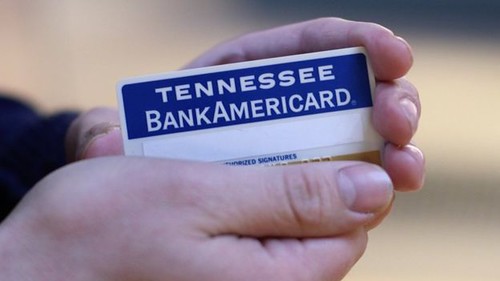
To read the complete article, see:
Money making: A brief history of currency from the British Museum
(www.bbc.com/news/business-36047863)
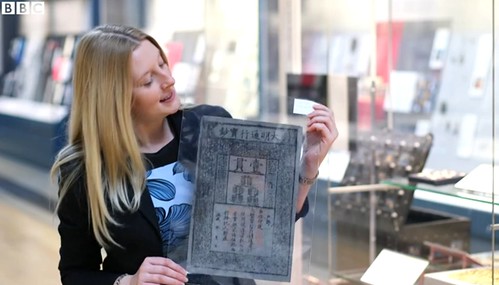
In September the Bank of England will introduce the first £5 notes made of plastic.
BBC News visited the Citi Money Gallery at the British Museum to look at five key objects that have been used as monetary tokens in previous societies.
To view the video, see:
Journey to plastic: A history of money in five objects
(www.bbc.com/news/business-36056401)
VIEWING COINS ONLINE IN THREE DIMENSIONS

Ray writes:
I was directed to this link on a Spanish Cob forum. The coin pictured is a plata corriente - a crude Spanish American coinage I have a fascination for. BUT it doesn't matter what coin it is - look at how it can be rotated and viewed at any angle!!! I'd love to have this feature while auction lot viewing online!
To view the 3D coin image, see:
Plata Corriente, St. Johns/Santa Clara Shipwreck
(https://sketchfab.com/models/879c5bf9294449df95ee61fd8a02e97f)
MONEY OF THE FUTURE: QUANTUM BANKNOTE PROTOTYPE
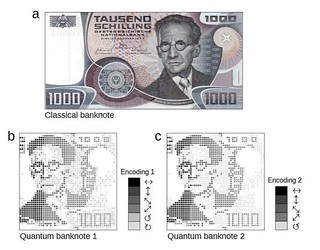 A group of physicists has reportedly presented what may well be a prototype for fraud-proof 'quantum money'.
A group of physicists has reportedly presented what may well be a prototype for fraud-proof 'quantum money'.
Using an image encoded in the polarization states of single photons, the researchers experimentally confirmed that it is possible to create a banknote that would be virtually immune to unauthorized replication due to the fact that unknown quantum information cannot be perfectly copied. It should be noted that the published image is merely a prototype, as actual quantum money hasn't been printed yet.
The idea of 'quantum money' was originally proposed by physicist Stephen Wiesner, who in a paper that was published in 1983 argued that by using quantum physics one could create banknotes that would be impossible to forge.
To read the complete article, see:
Money of the Future: Scientists
Present Quantum Banknote Prototype (http://sputniknews.com/science/20160424/1038525922/forgery-proof-quantum-moeny-prototype.html)

CURATING THE DIGITAL AGE
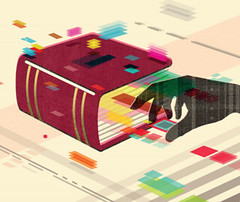 Les Citrome forwarded this article on digital curation from the April 2016 issue of IEEE Spectrum. Thanks. It defines a number of
digital-age vocabulary words that readers ought to become familiar with. See the complete aticle online for more terms, including dark
archives and media migration. All of these have relevance to the work of the Newman Numismatic Portal. -Editor
Les Citrome forwarded this article on digital curation from the April 2016 issue of IEEE Spectrum. Thanks. It defines a number of
digital-age vocabulary words that readers ought to become familiar with. See the complete aticle online for more terms, including dark
archives and media migration. All of these have relevance to the work of the Newman Numismatic Portal. -Editor
[T]he belief that our life offline is separate from our life online has been denounced as digital dualism. But there’s less of a debate when it comes to differentiating between analog objects and digital data. Yes, the print and electronic copies of the same book contain the same words, but it’s obvious to most people (and, increasingly, to researchers) that the two reading experiences are quite different.
We need to understand such differences because the world is going to see a lot more digital data in the near future. This includes born-digital data, which is originally created in an electronic format, as well as born-analog data, which starts life as a physical object and then is reborn digital. A great example of this digitization came earlier this year when the New York Public Library announced that it was making more than 180,000 digitized items available to anyone with an Internet connection, no questions asked.
That librarians would turn themselves into digital curators is no surprise, since as analog curators for the past few centuries they have been constantly bumping into the physical constraints of storage space and material decay. One approach is to get rid of stuff, and librarians and archivists employ a pleasing variety of terms related to the removal of unwanted or duplicate material from their collections: Weeding and culling generally refer to the removal of individual items, while purging, screening, and stripping are most often used for the removal of multiple related items. But the main problem with physical materials is that they possess what archivists call, poetically, inherent vice: the tendency for something to deteriorate over time because of some fault in the material itself (for example, the presence of lignin in cheap paper, which causes the paper to yellow) or the way the material reacts with its surroundings (for instance, the fact that bugs eat some books because they’re attracted to the mold that grows in damp paper).
The digitization of analog materials can solve these problems, and engineers are constantly trying to find faster ways to turn atoms into bits. For now, though, we mostly have to rely on the skills of scanops (scanner operators) to generate those bits, although on their less skilled days those operators end up scanning their own body parts, such as fingers and hands, a phenomenon known as Google hands. Some companies are applying the principles of crowdsourcing and gamification to the digitizing realm, creating leisure activities that let users contribute to the process.
To read the complete article, see:
Curating the Digital Age
(http://ieeexplore.ieee.org/stamp/stamp.jsp?tp=&arnumber=7439589)
DO YOU SUFFER FROM LIBRARY ANXIETY?
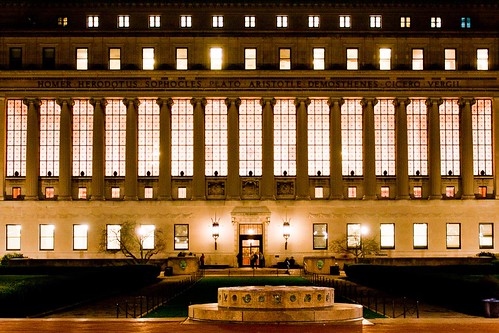
Gillian S. Gremmels still remembers the aha moment she had when, as a reference librarian at DePauw University in Indiana, she first read “Library Anxiety: A Grounded Theory and Its Development” by Constance A. Mellon in the March 1986 issue of College & Research Libraries.
“The resonance I felt when I read about library anxiety was powerful,” she wrote in the same journal nearly 30 years later. “[Y]es, I thought; this is what I’m seeing in my students, who seem overwhelmed by the library, in need of librarians’ help, yet reluctant to approach us.”
That term—library anxiety—is hardly a household name among students, but say it to a college librarian, and he or she will know exactly what you’re talking about. It’s the feeling that one’s research skills are inadequate and that those shortcomings should be hidden. In some students it’s manifested as an outright fear of libraries and the librarians who work there. To many librarians it’s a phenomenon as real as it is perplexing.
“Why would anyone think we are intimidating?” writes Michel C. Atlas. “What is intimidating about a master’s-prepared professional earning $35,000 a year?”
Librarians have been discussing the general phenomenon since at least the mid-to-late 1970s, says Ann Campion Riley, president of the Association of College & Research Libraries, but it was Mellon who first gave it a name three decades ago. Her original study was based on analysis of journal entries college students had been required by their instructors to keep during the research process. After reading the student diaries, Mellon concluded, “Seventy-five to 85 percent of students in each class described their initial response to the library in terms of fear or anxiety.”
“Terms like scary, overpowering, lost, helpless, confused, and fear of the unknown appeared over and over again,” Mellon wrote. One student admitted to feeling like a “lost child”; another said she was “lost in there and actually scared to death.”
According to Mellon, three general themes emerged: Students found their own library skills inadequate; they found their perceived shortcomings shameful; they feared seeking out help would only reveal their inadequacy.
So where does this all leave the student who’s still fearful of making that first approach to the reference desk? Librarian Michel C. Atlas has some age-old, conventional wisdom to offer: “[T]he bottom line on library anxiety—just get over it!”
To read the complete article, see:
DO YOU SUFFER FROM LIBRARY ANXIETY?
(http://daily.jstor.org/do-you-suffer-from-library-anxiety/)
THE LIBRARIAN BY GUISEPPE ARCIMBOLDO
The Librarian
Ron Haller-Williams writes:
I think I've found a bust of you on eBay (or maybe it is of some other bibliophile!)
GUISEPPE ARCIMBOLDO
"The Librarian" (Original emerged 1566 - oil on canvas)
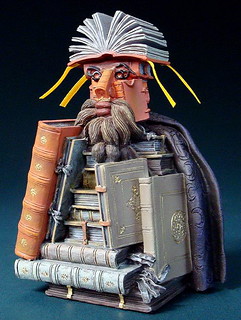 About THE FACTORY AND THE ARTIST:
About THE FACTORY AND THE ARTIST:
Fantastic talent and eccentric portraits with plenty of humor made Giuseppe Arcimboldo, one of the most bizarre artists of the Renaissance, world famous. His composition portraits in he known contemporaries of flowers, fruits, leaves, fish, and books together mensetzte, are unique in their kind.
Arcimboldo's surprising collages images exude wit and irony and were already on half a millennium extremely popular. Was due to its imaginative representations Arcimboldo one of the models for the surrealists of the 20th Century. So interpreted eg Salvador Dalí several motifs of the Renaissance master in his own works.
To read the complete eBay lot description, see:
GUISEPPE ARCIMBOLDO - "The Librarian" MUSEUMS Replica, Sculpture Figure Size
S (www.ebay.co.uk/itm/271531092178)
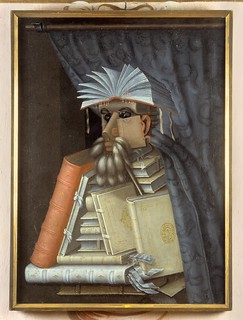 The Librarian is an oil on canvas painting by Giuseppe Arcimboldo in the collection of Skokloster Castle in Sweden. It is thought to
be a portrait of Wolfgang Lazius, a humanist and historian who served Holy Roman Emperors of the House of Habsburg.
The Librarian is an oil on canvas painting by Giuseppe Arcimboldo in the collection of Skokloster Castle in Sweden. It is thought to
be a portrait of Wolfgang Lazius, a humanist and historian who served Holy Roman Emperors of the House of Habsburg.
Arcimboldo became official portraitist to Emperor Maximilian II in 1562. The Librarian is one of a series of paintings by Arcimboldo of members of Maximilian's entourage. Skokloster Castle dates the painting to 1562, though the painting is more often dated circa 1566.
Arcimboldo created a number of portraits of people by painting an assemblage of objects such as fruits and vegetables, flowers, or in this case, books; the objects typically had some connection to the person's life or depiction. Benno Geiger called it a "triumph of abstract art in the 16th century". In 1957, art historian Sven Alfons was the first to conclude that this was specifically a portrait of Lazius. The work has been interpreted as both a celebration and a satirical mocking of librarians and scholarship. K. C. Elhard suggests that it may be specifically a parody of "materialistic book collectors more interested in acquiring books than in reading them."
Elhard notes that The Librarian has become "a fixture in the visual history of the library profession". However, the original title, if any, is unknown, and its current title first appears (in Swedish as "Bibliotekarien") in an early 20th-century inventory.
To read the complete Wikipedia entry, see:
The Librarian (painting)
(https://en.wikipedia.org/wiki/The_Librarian_(painting))
FEATURED WEB SITE: MINTAGE WORLD
This week's Featured Web Site is Mintage World, an online museum of coins, notes, and stamps of India.Coins and notes are a part of our daily lives. We have used stamps while availing of postal service provided by the government. But seldom do we think about their origin, history, and evolution. Mintage World offers you a platform to discover the coins, stamps and notes of India. Mintage World is an online museum with an extensively researched collection of coins, notes, and stamps. It is a haven for Numismatists, Notaphilists, and Philatelists. It is also a place for history buffs to learn about the coins, notes, and stamps issued in India over the ages. This online museum provides information on ancient coins, medieval coins and modern Indian coins, Pre-Colonial, Colonial, and Republic paper currency, and Pre-Independence and Post-Independence stamps issued in India.
Mintage World is more than just an online museum. You can also check upcoming events such as coin fairs or auctions or you can read interesting titbits from the world of coins, notes, and stamps. This website is also a hub of historic information. There is more to Indian history than the freedom struggle, the Mughals, and the Mauryas. Read up on the numerous dynasties that ruled different parts of India at different times. Learn about the Janapadas, the Malwa Sultans, the Alupas, the Delhi Sultanates, the Western Kshatrapas, and more. Learn about their coins along with the names of their rulers through our 'History' section.
Mintage World is a one-of-its-kind online museum for coins, notes, and stamps in India. It is unique in its concept and the collection includes information on many coins issued by Indian rulers. The online museum of coins contains the largest collection on Indian coins. The online museum of notes houses information on all the paper money issued in India right from the 18th century; while the online museum of stamps displays all the stamps issued in India, right from the Scinde Dawk.
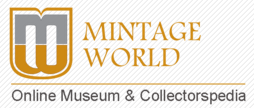
www.mintageworld.com

